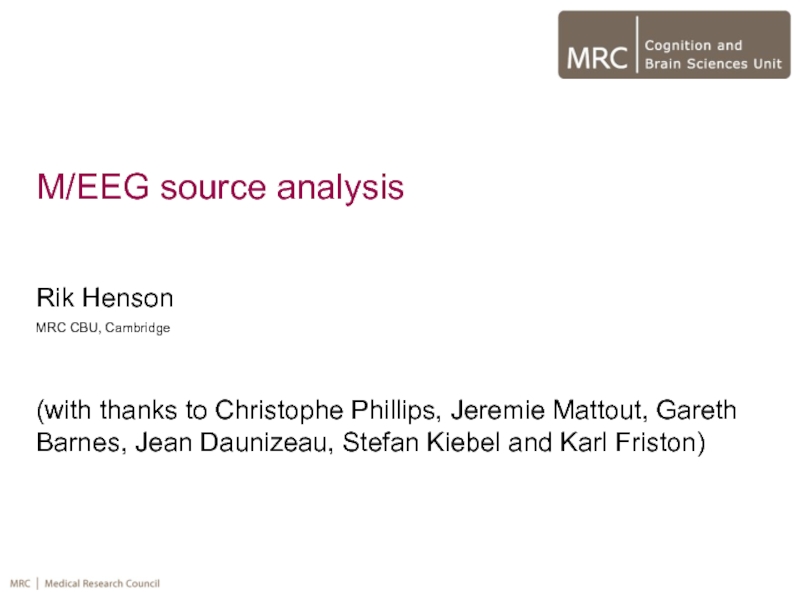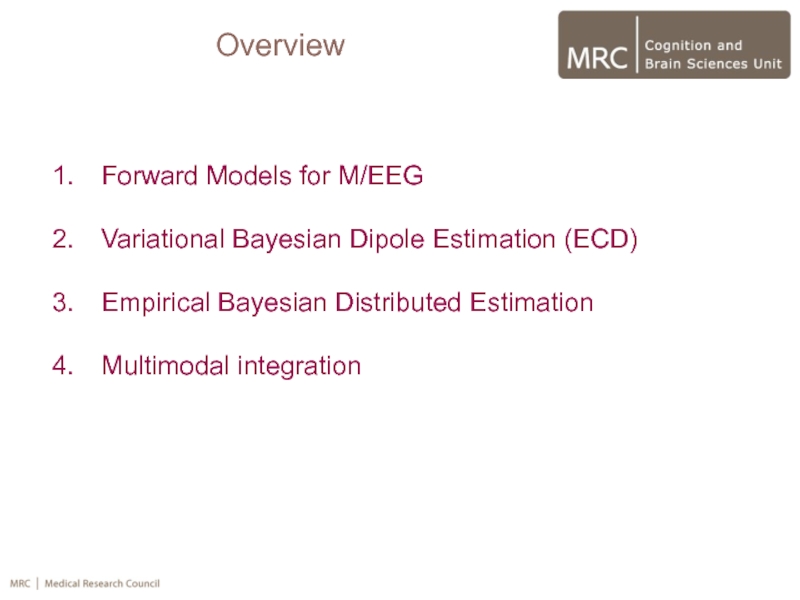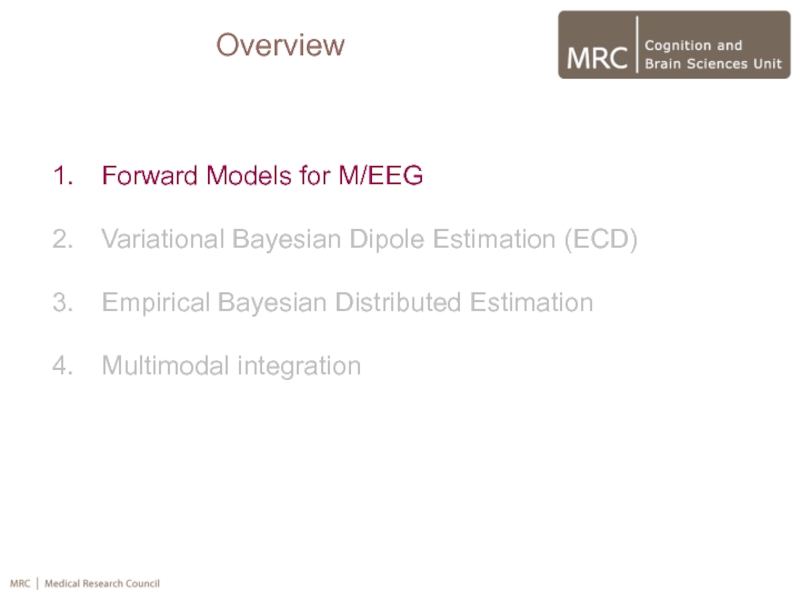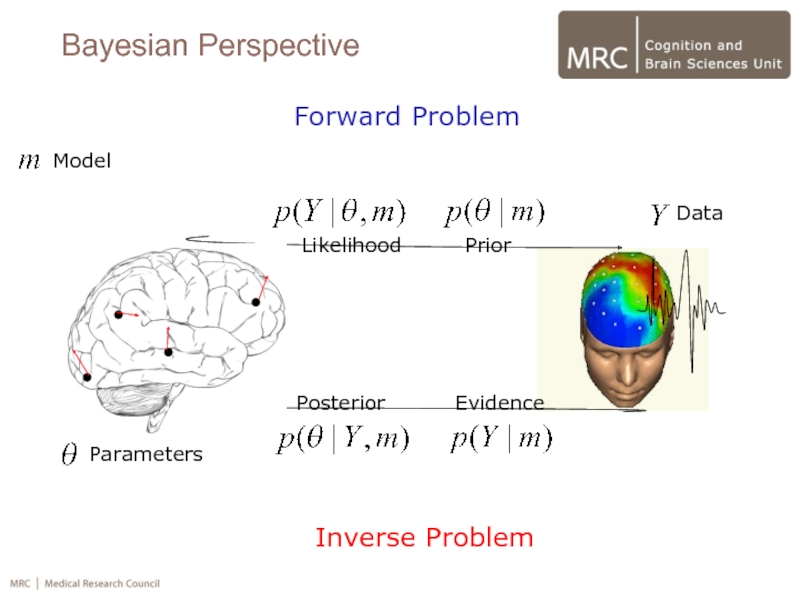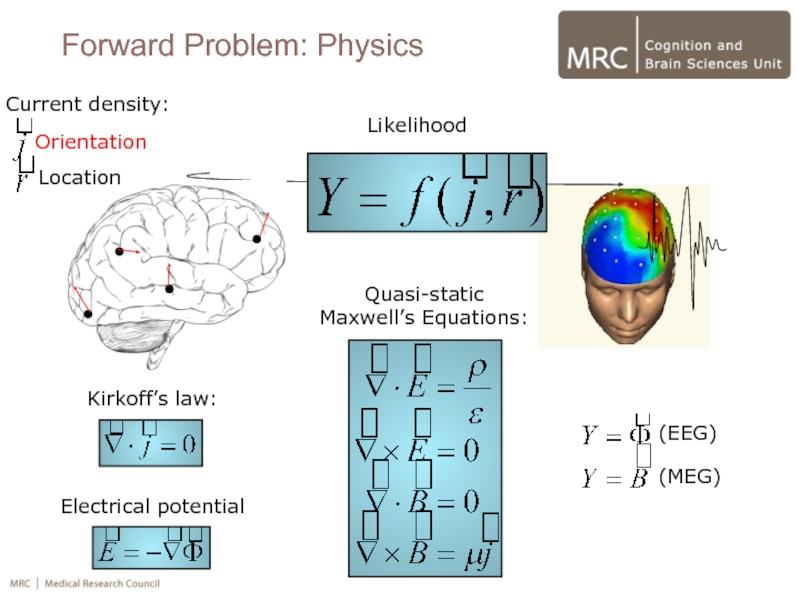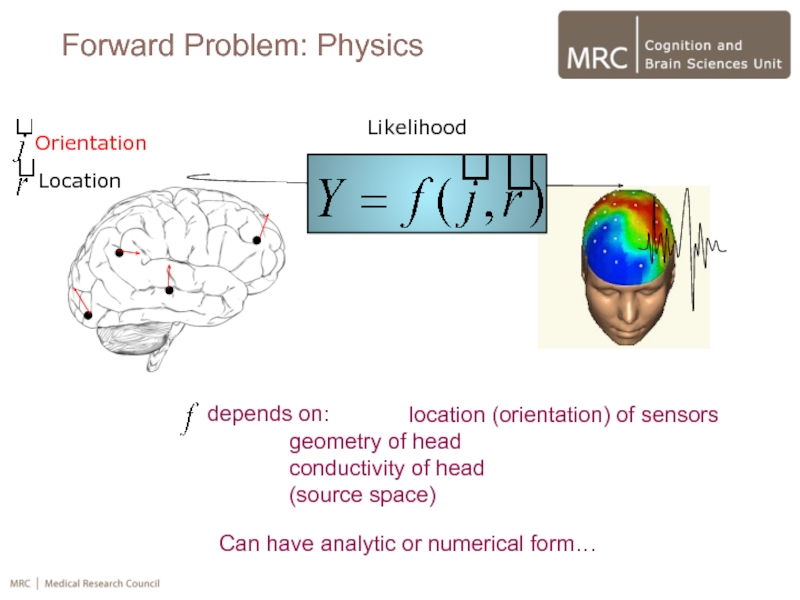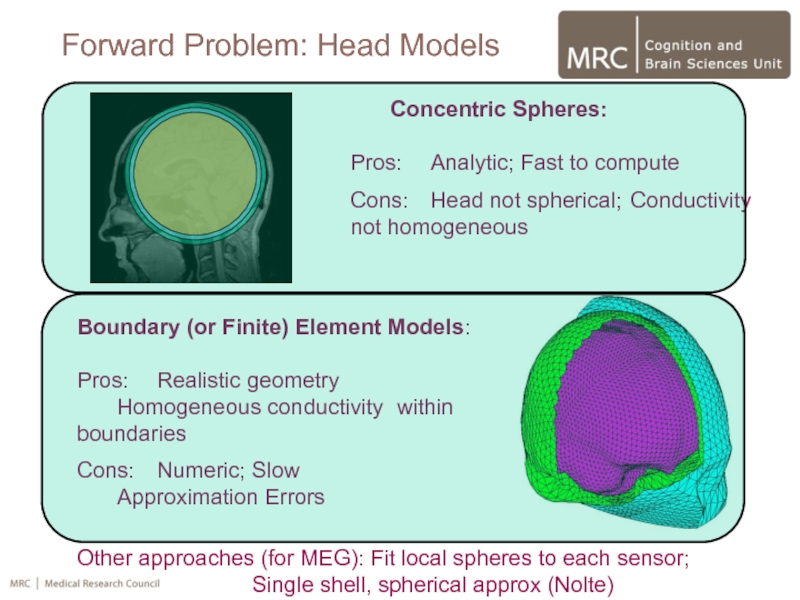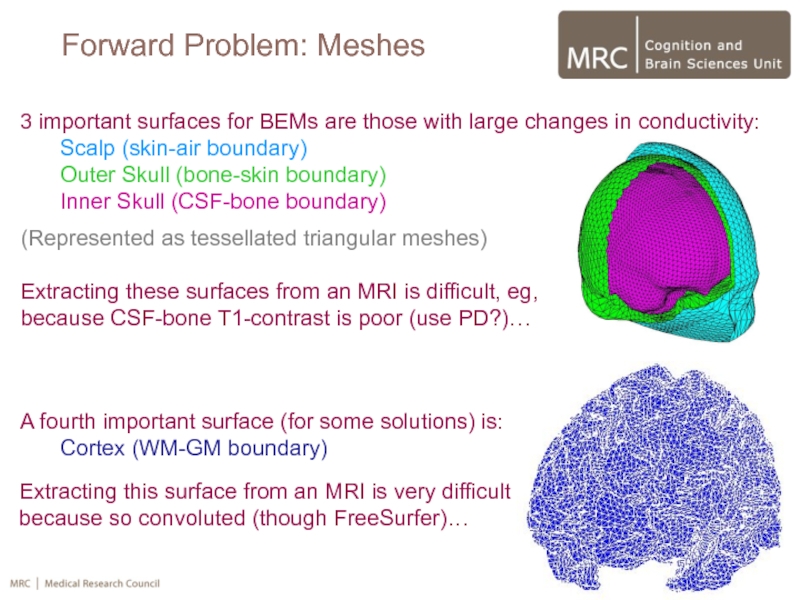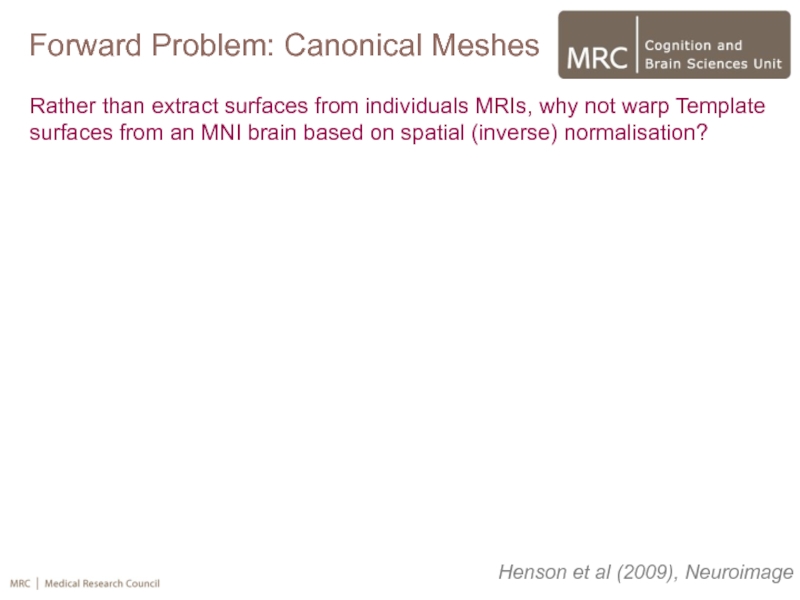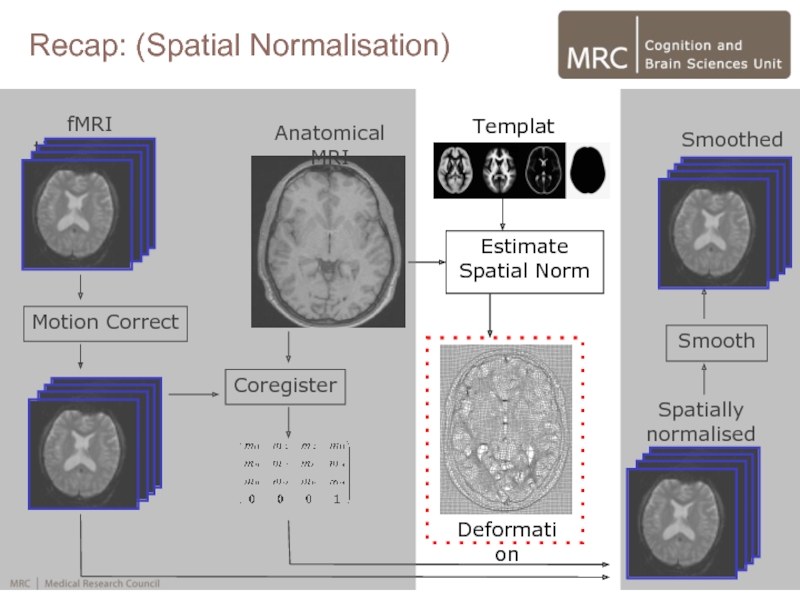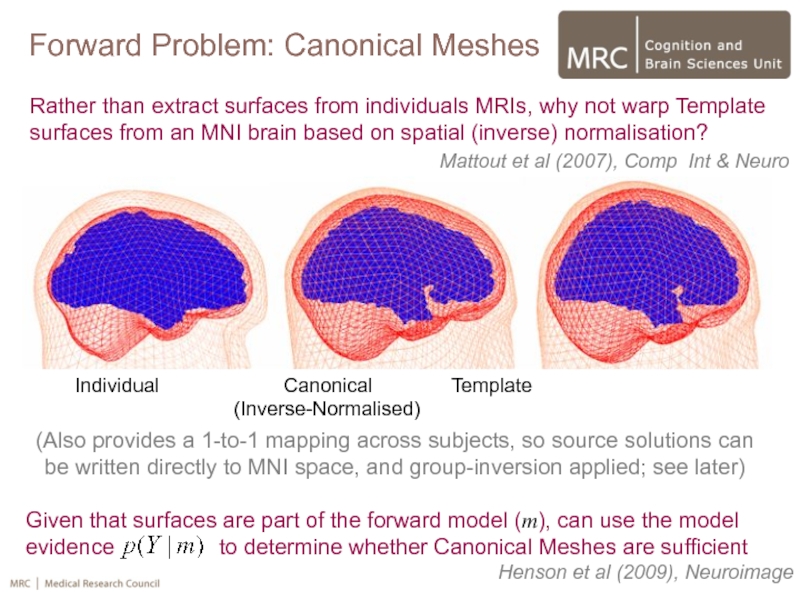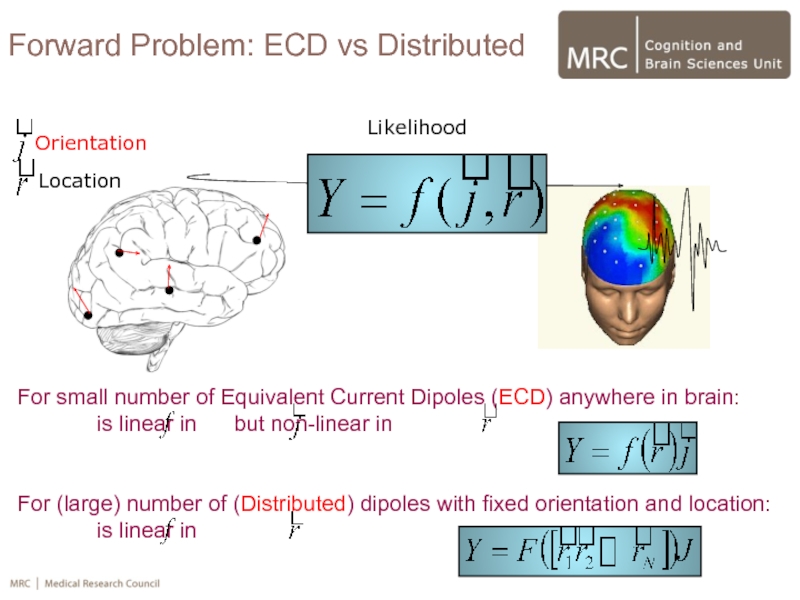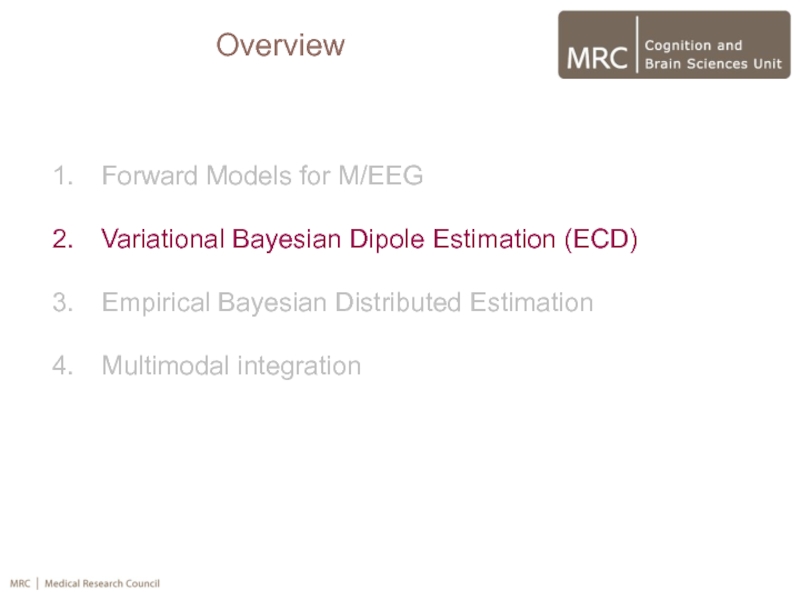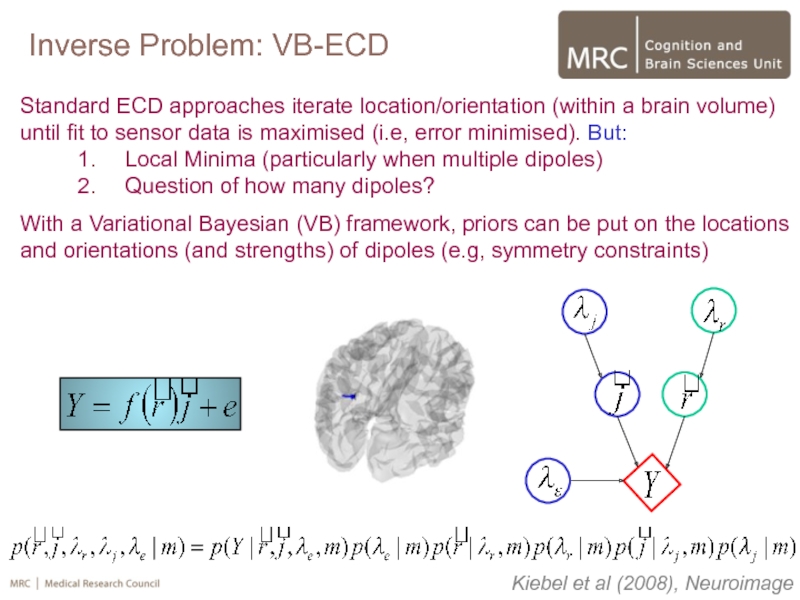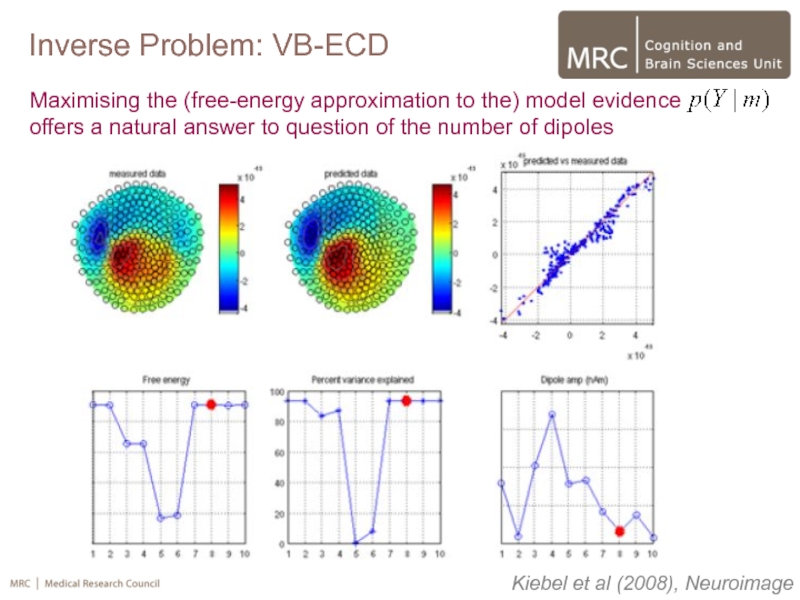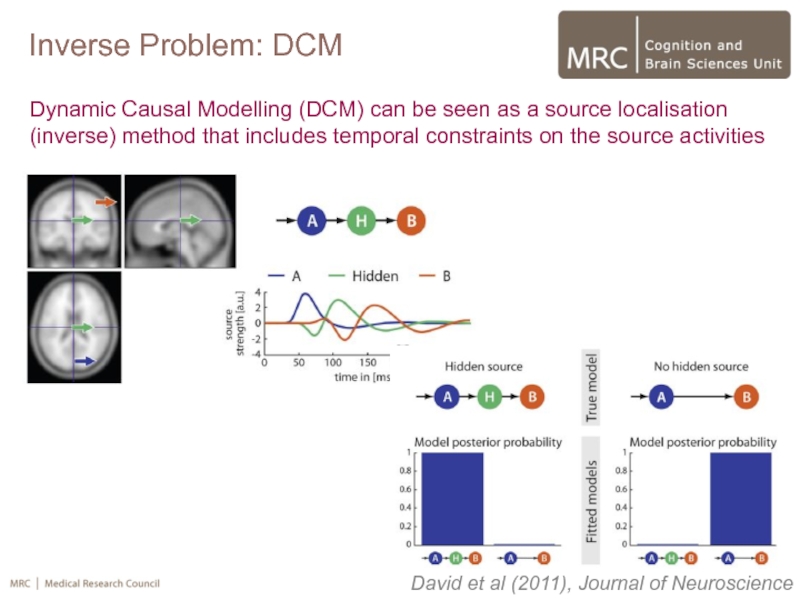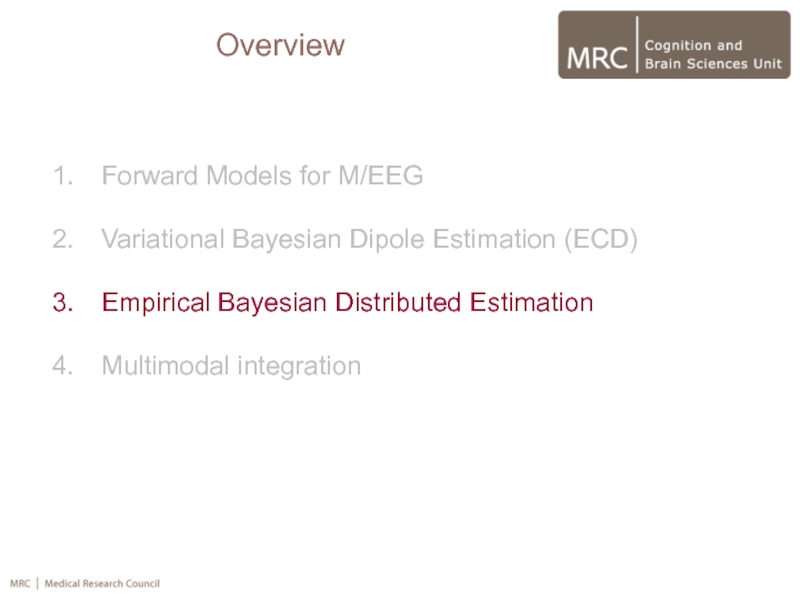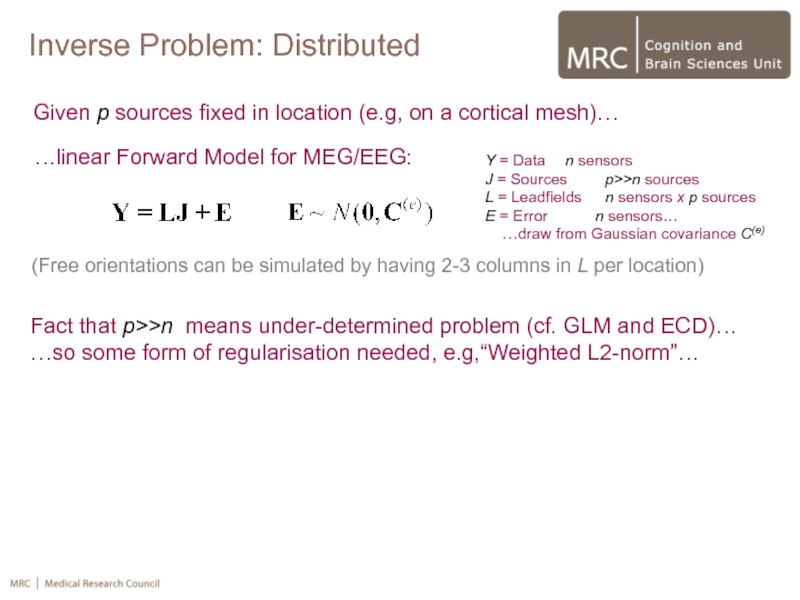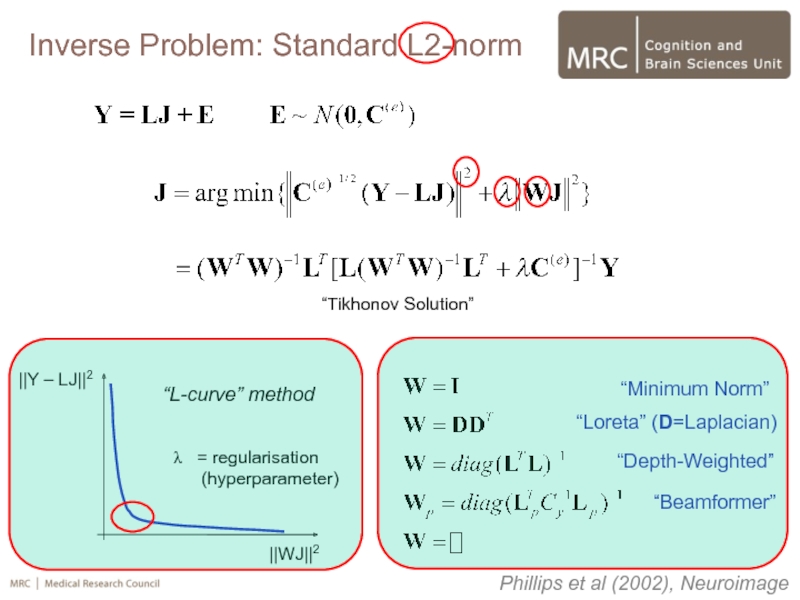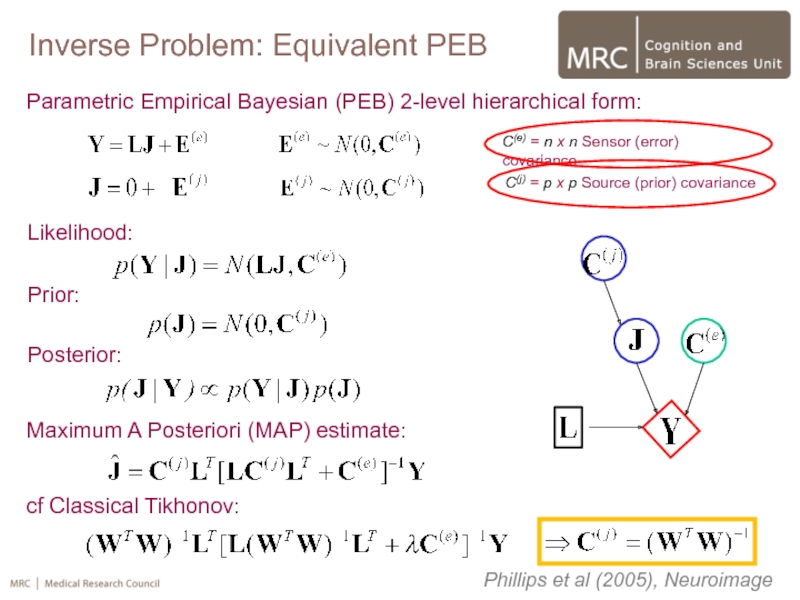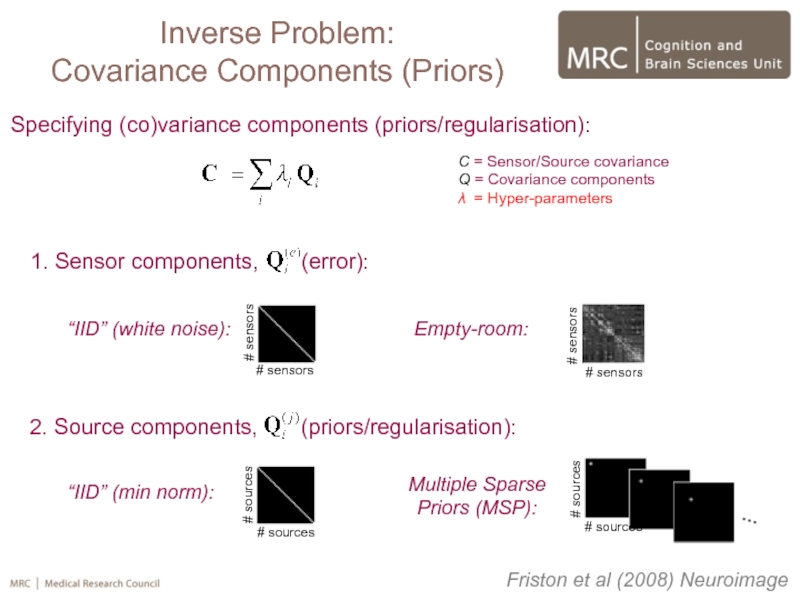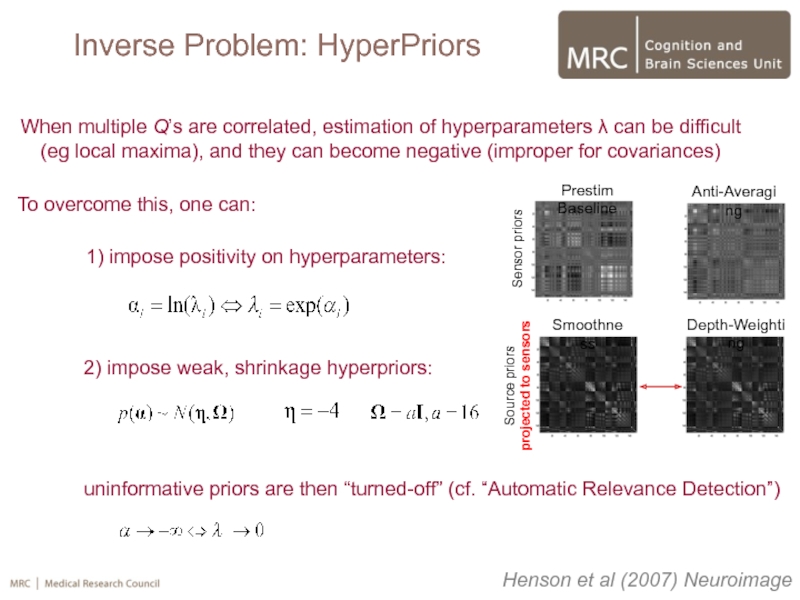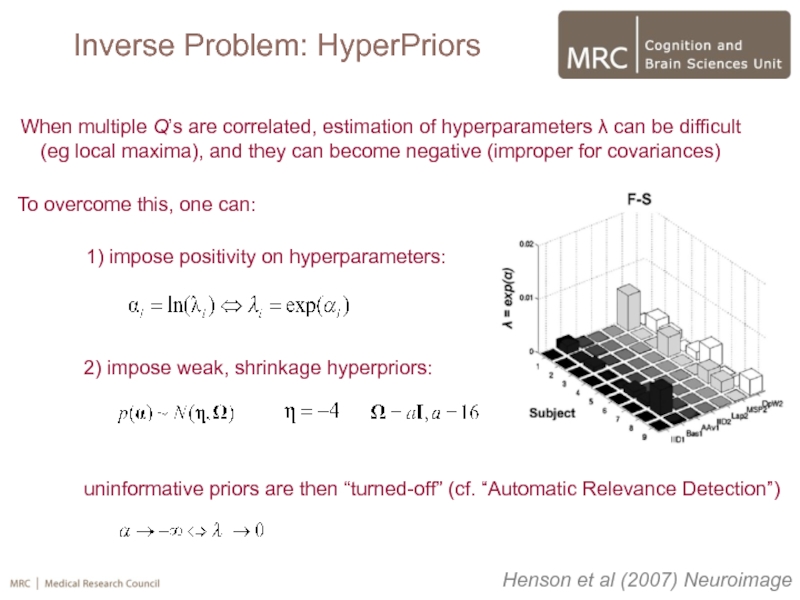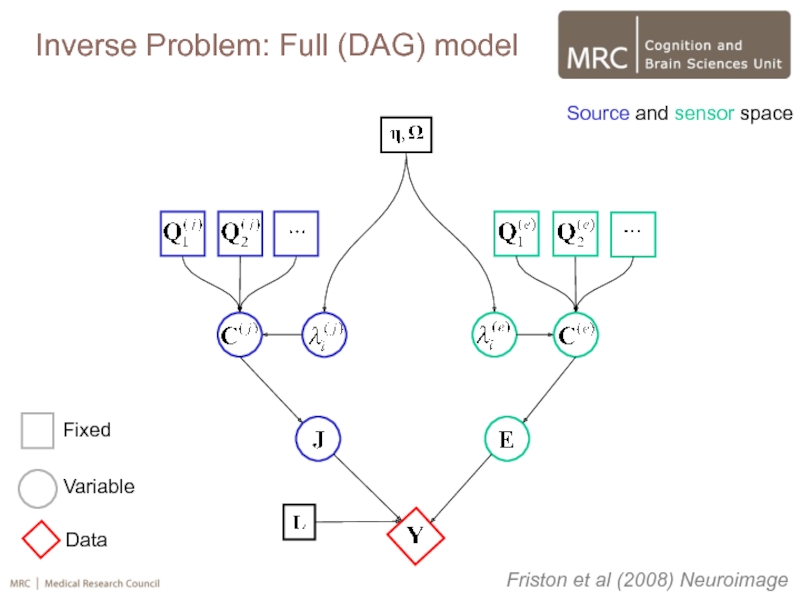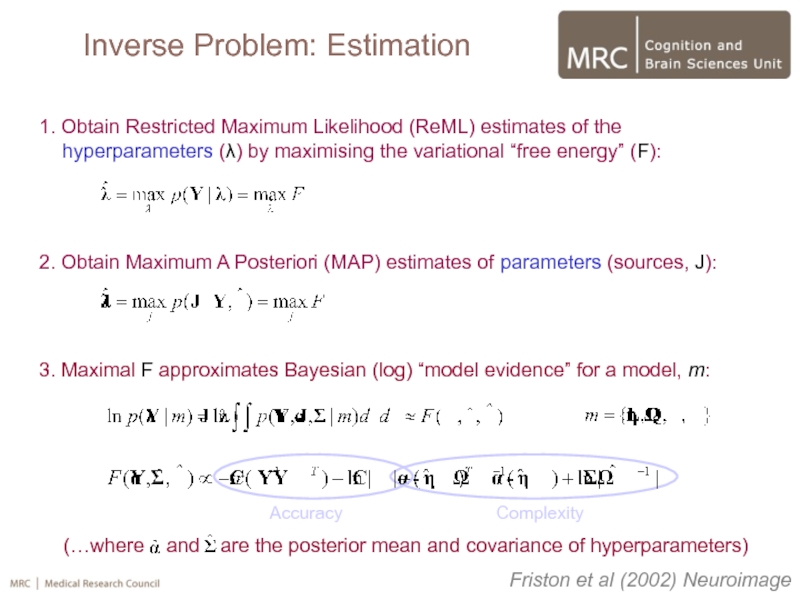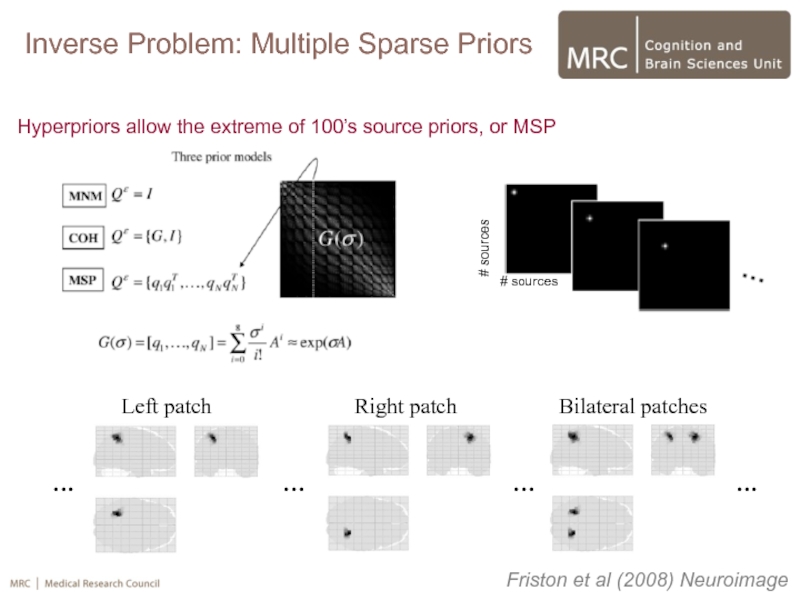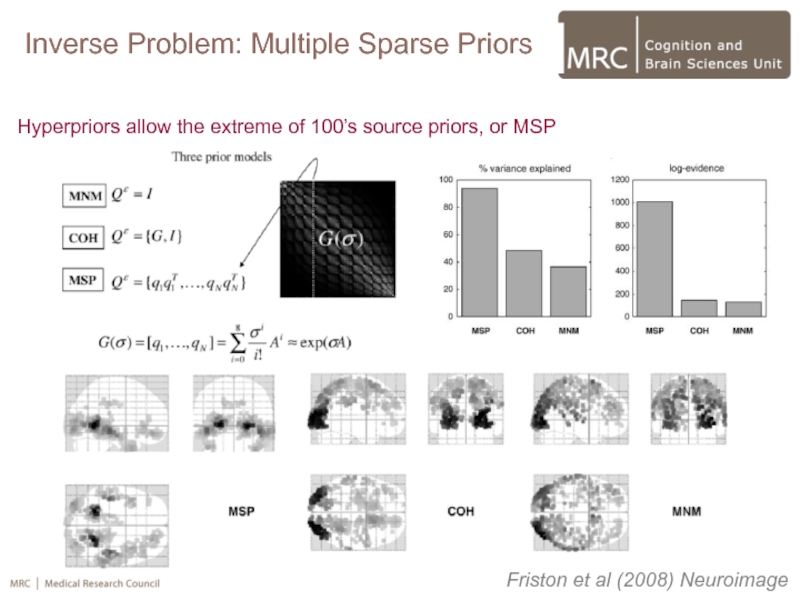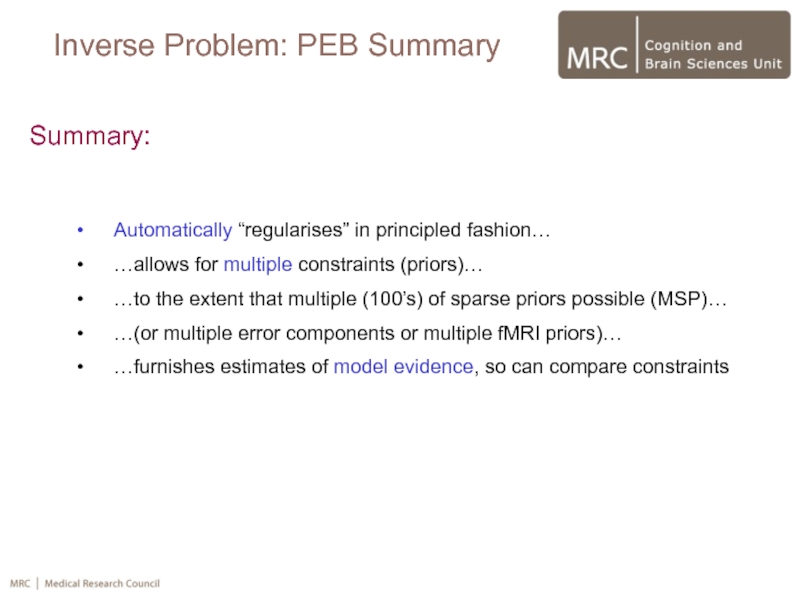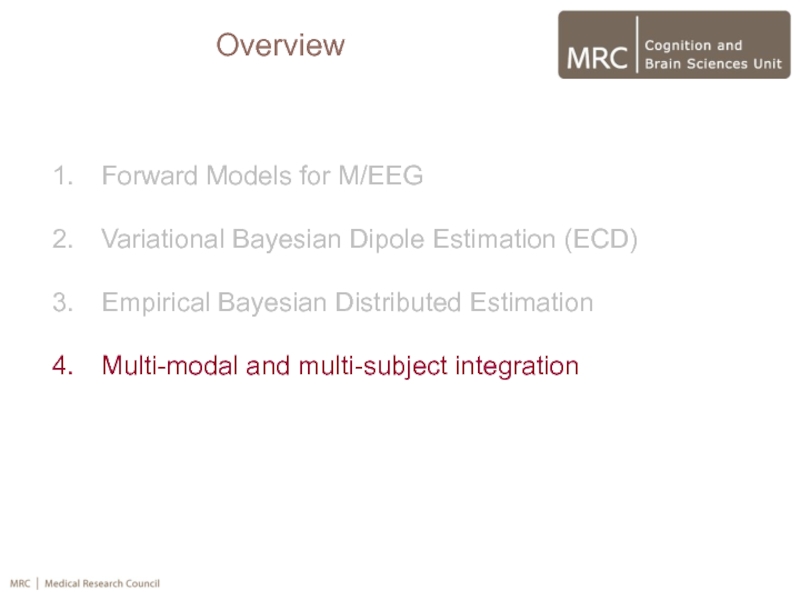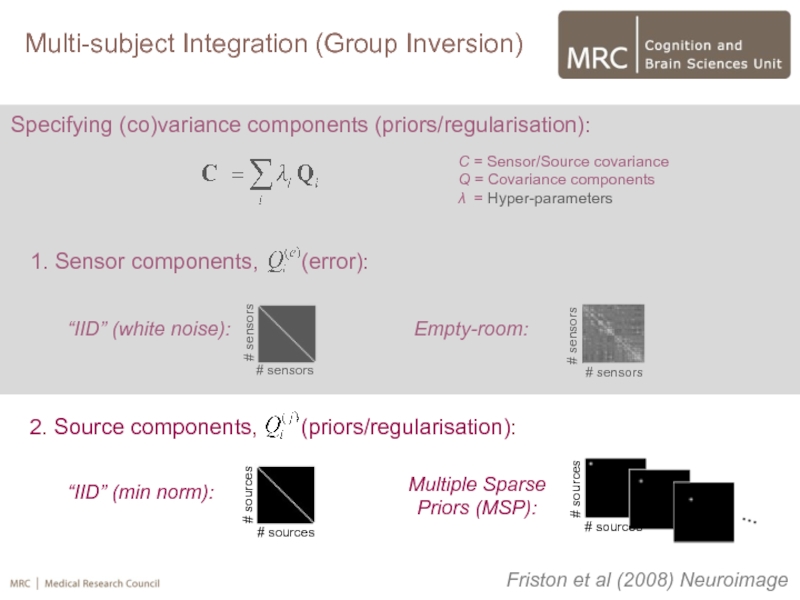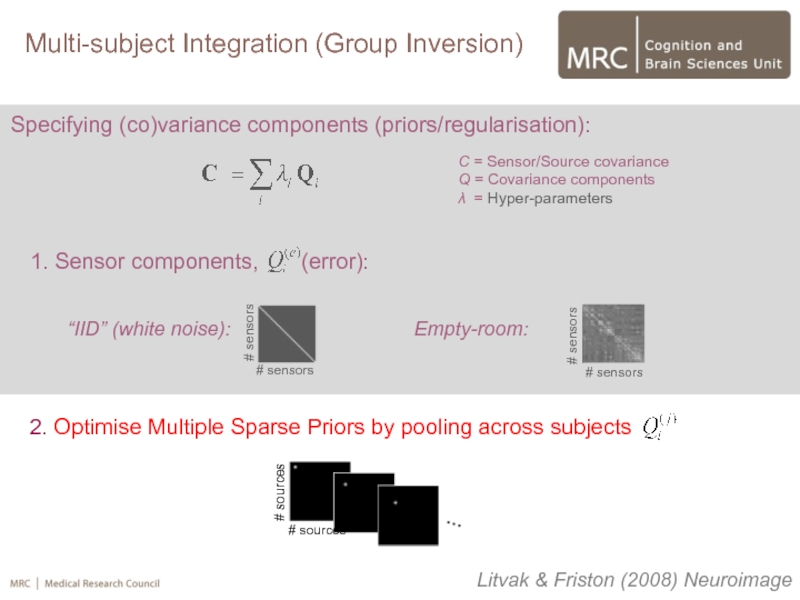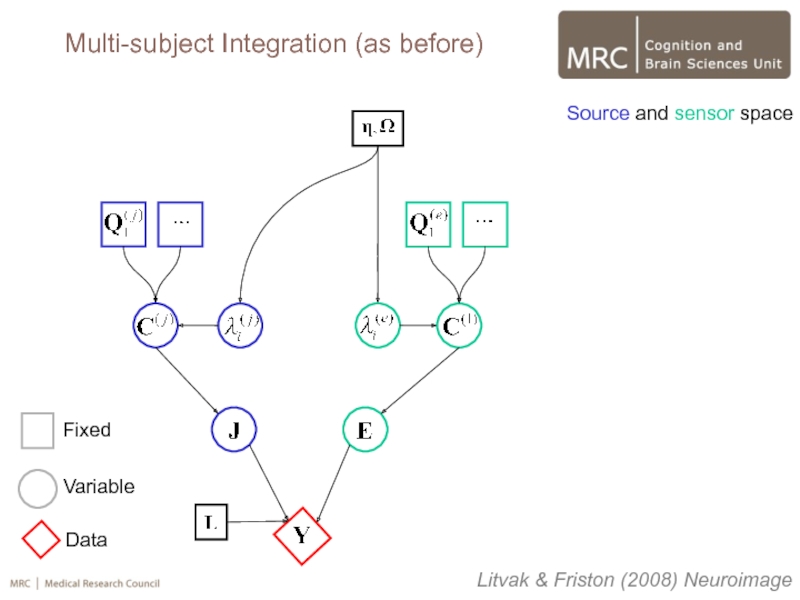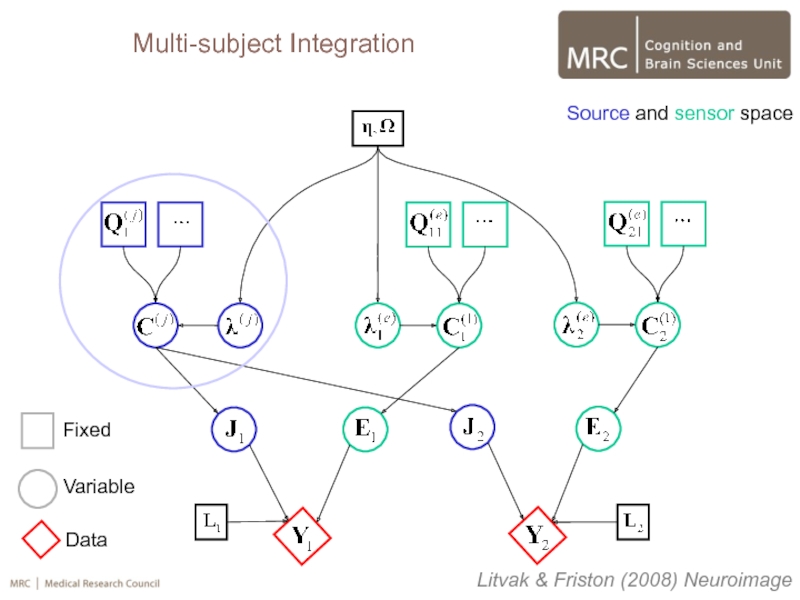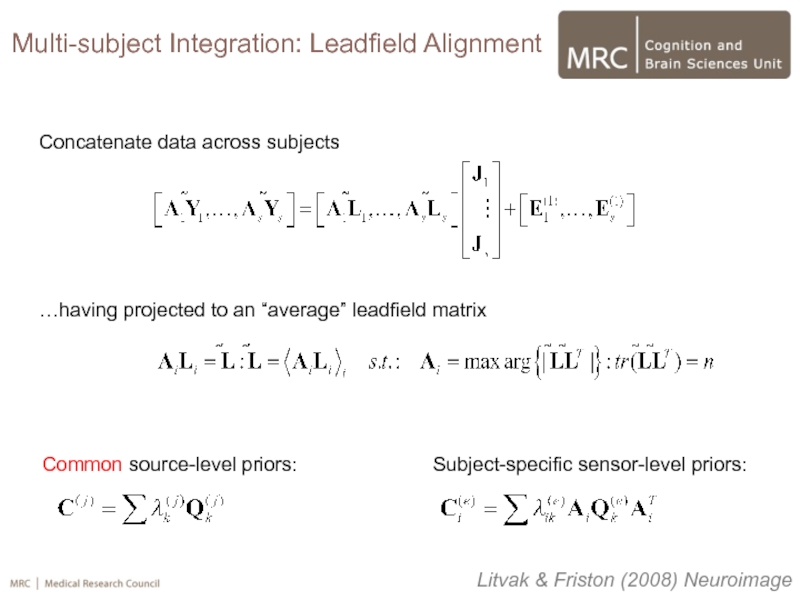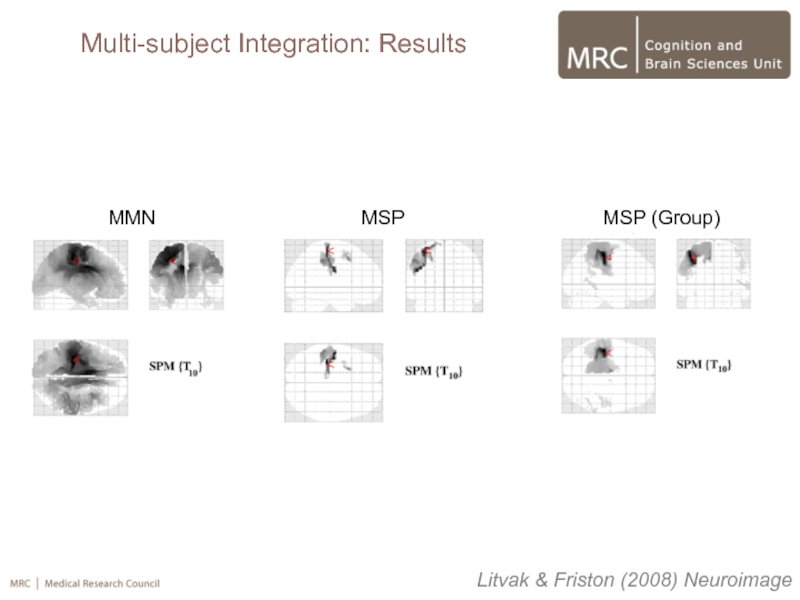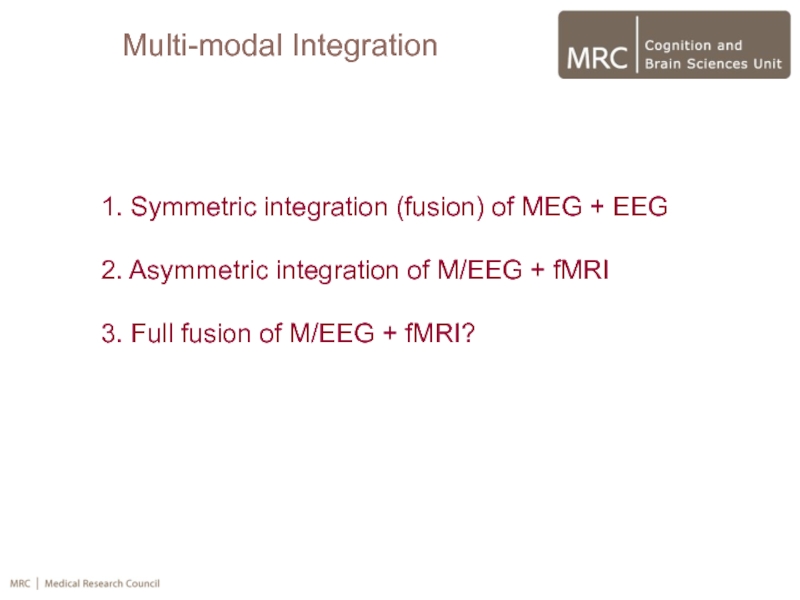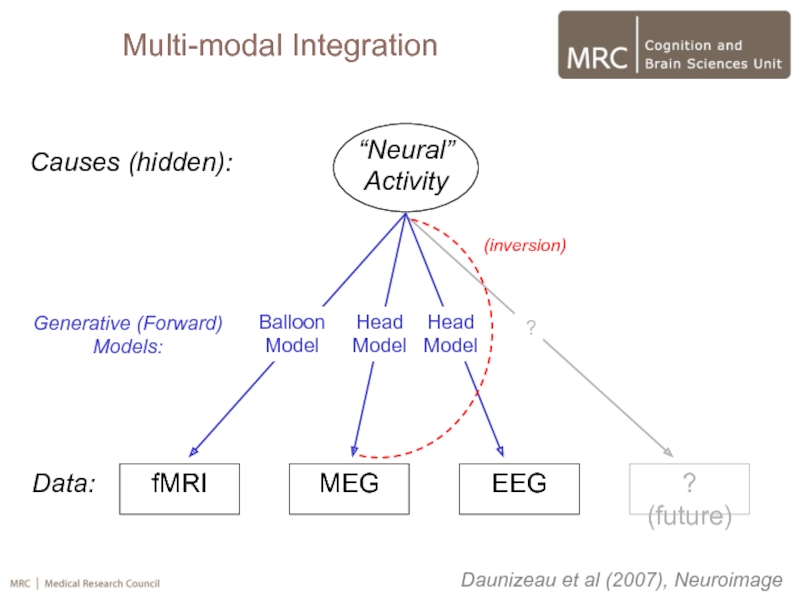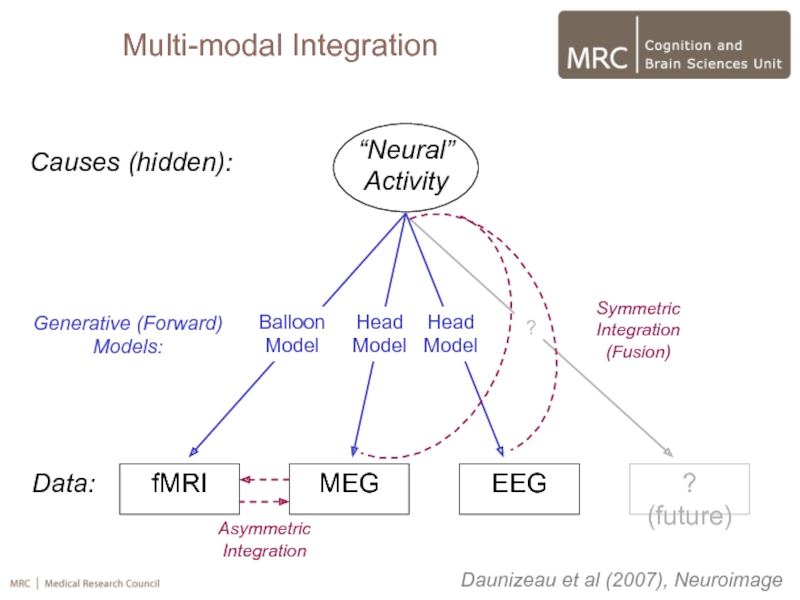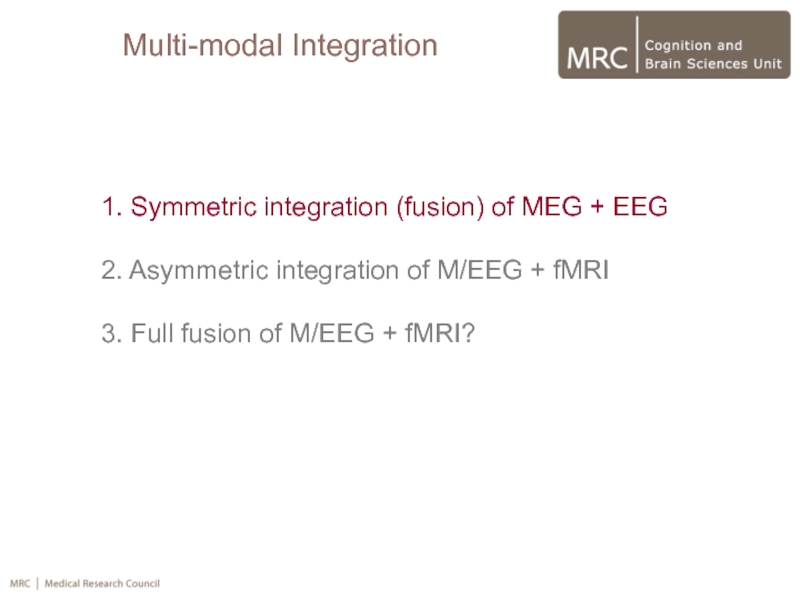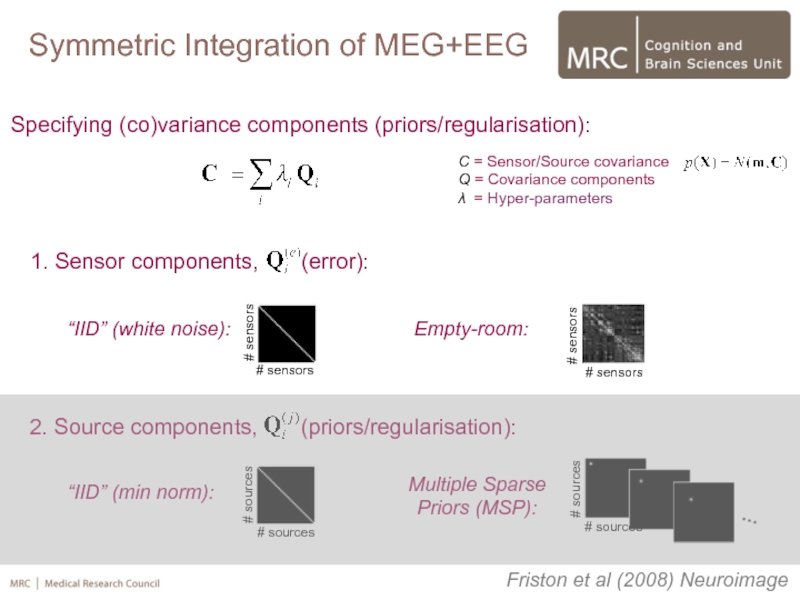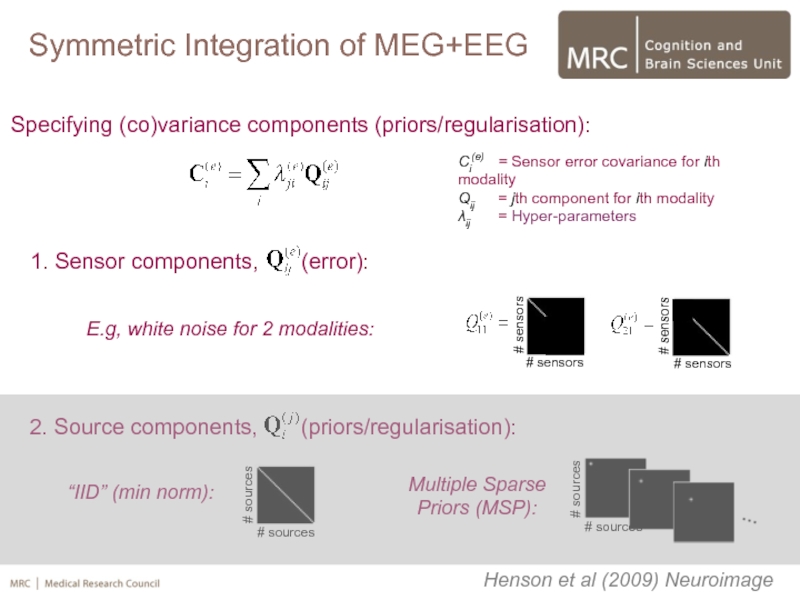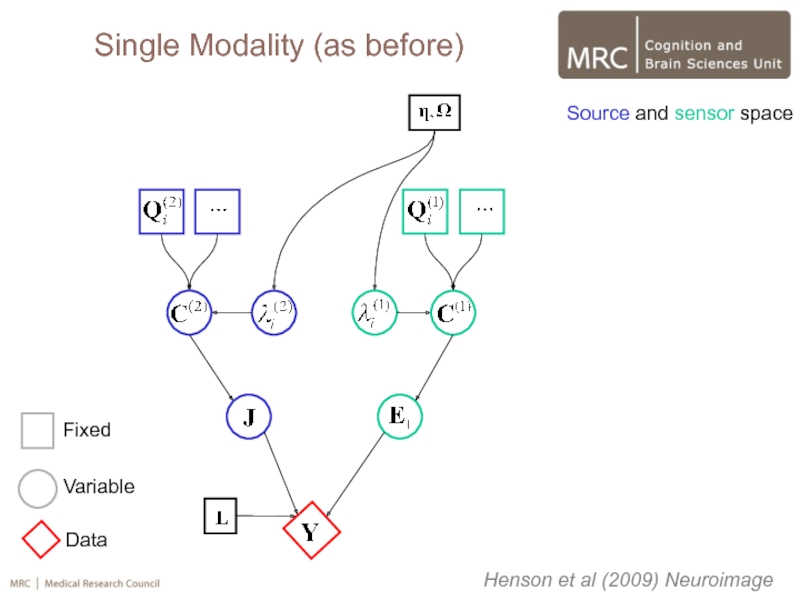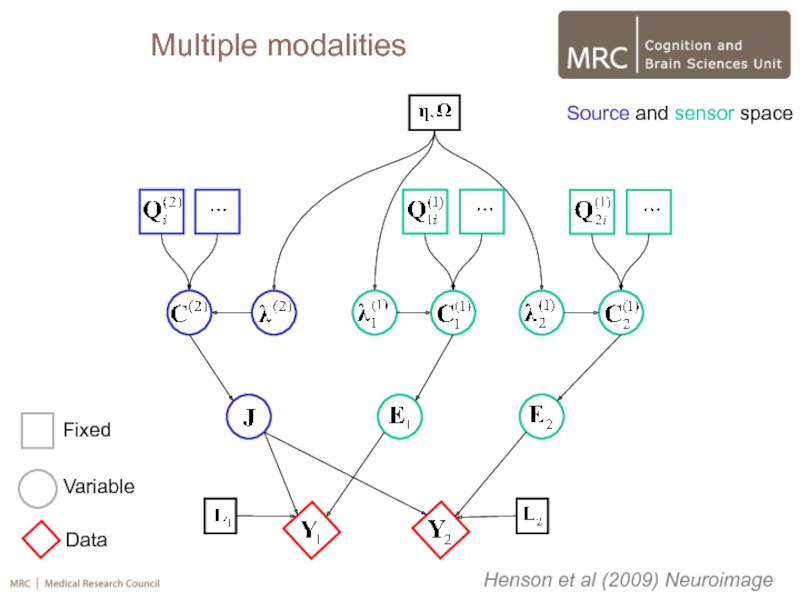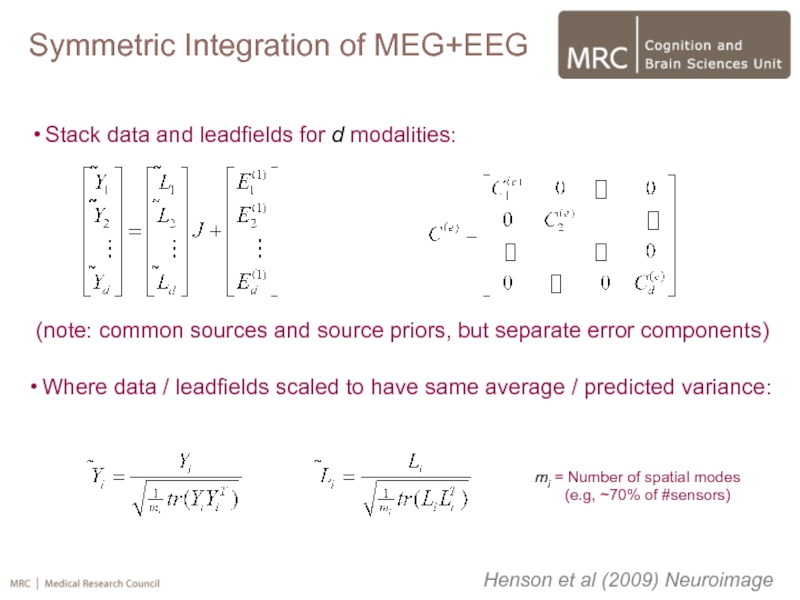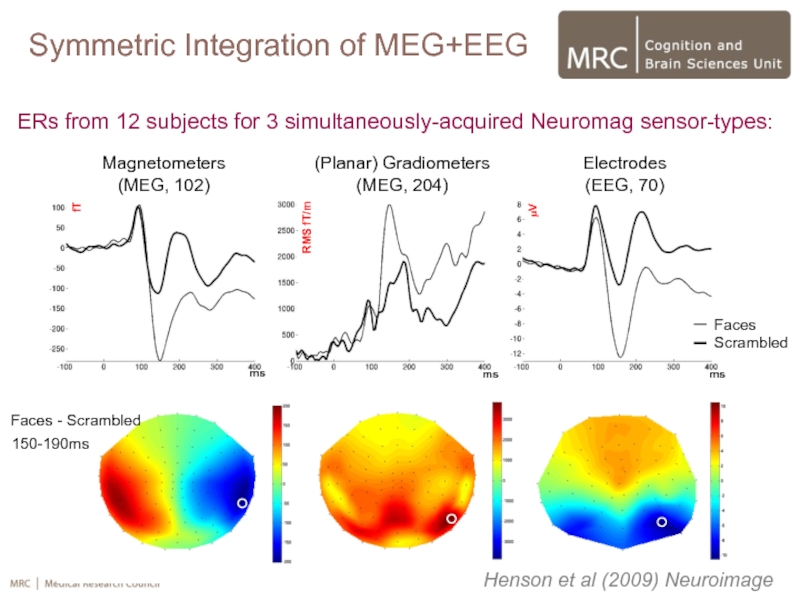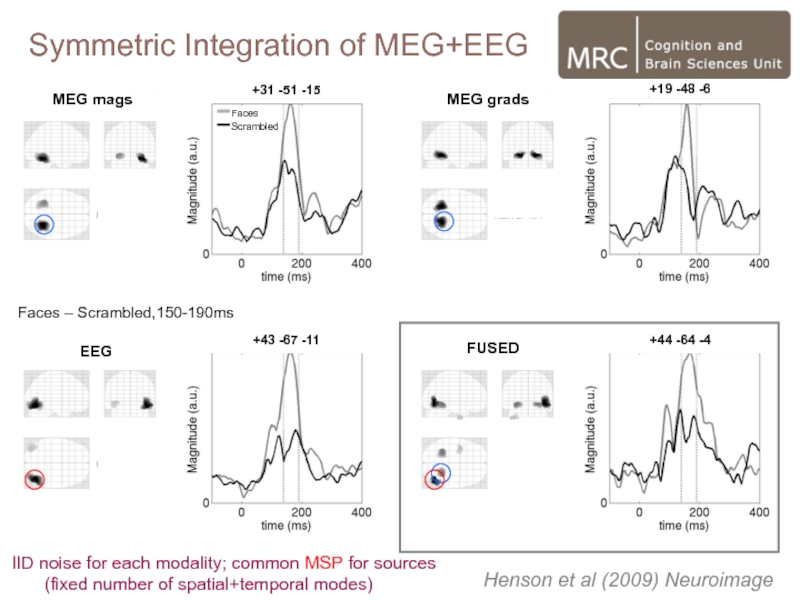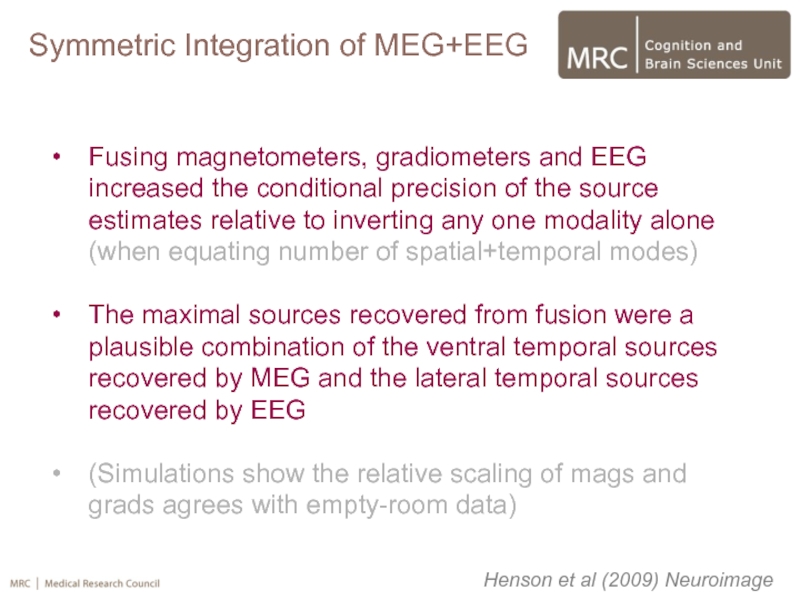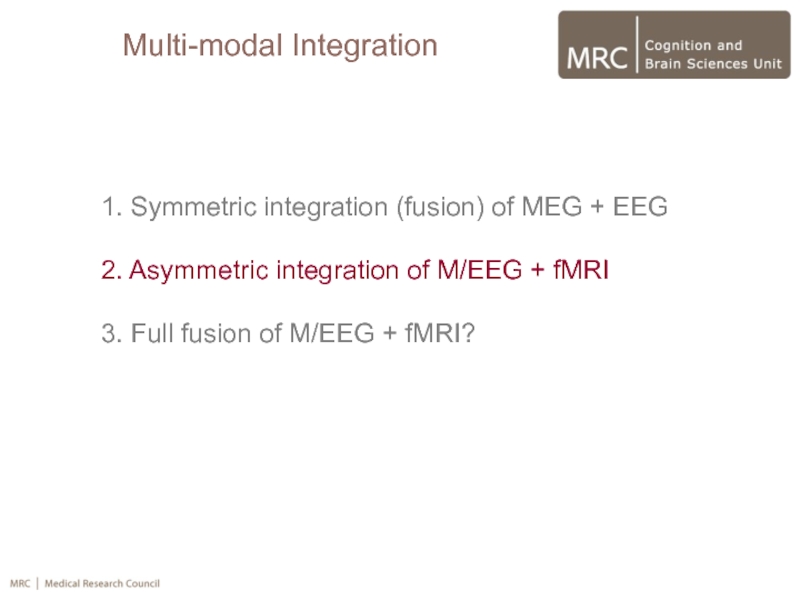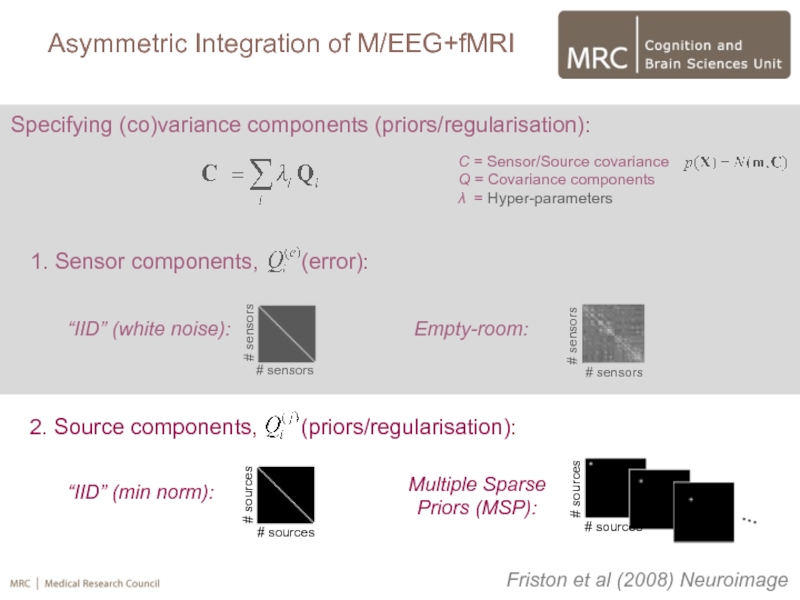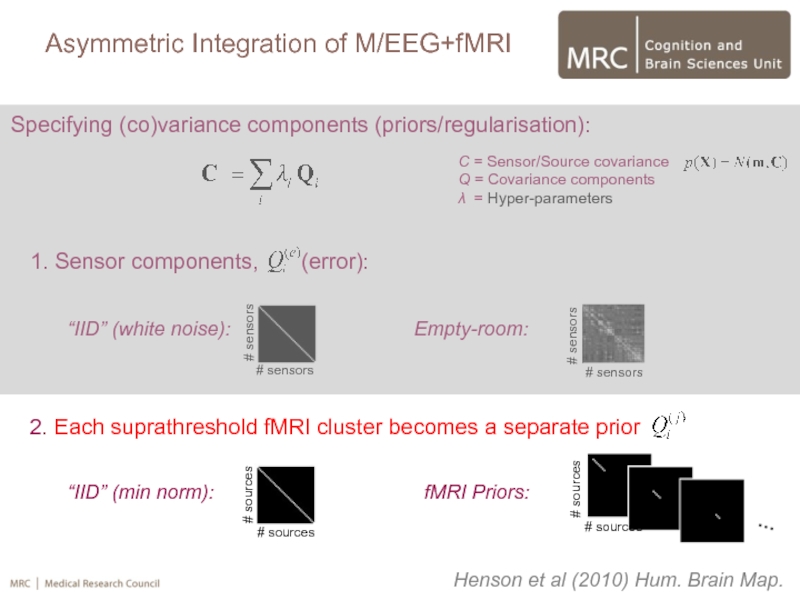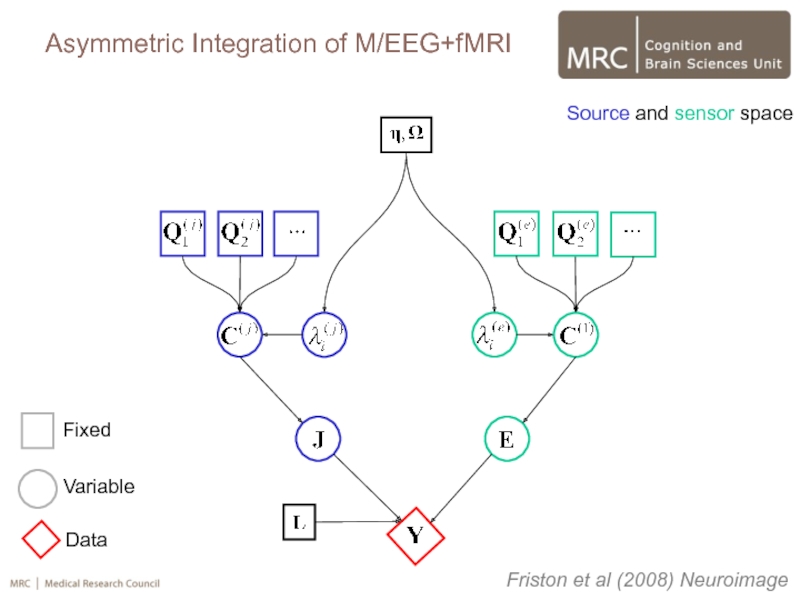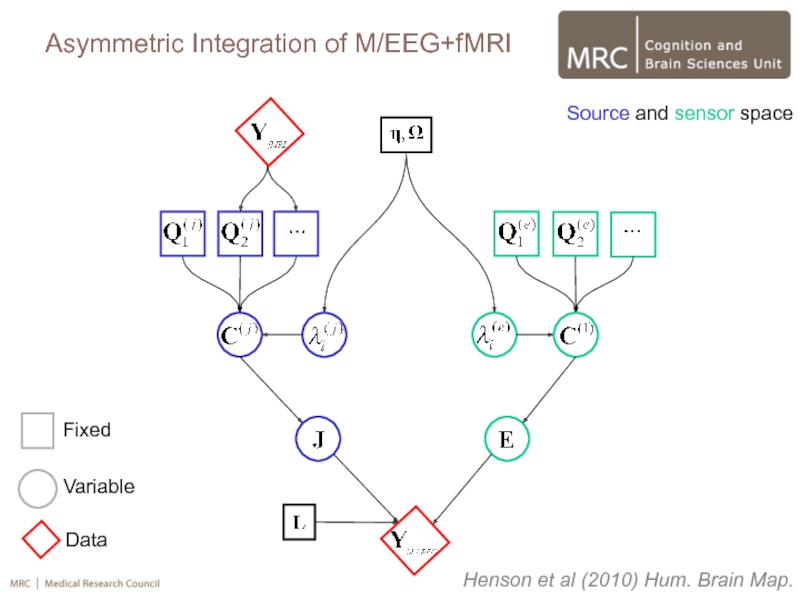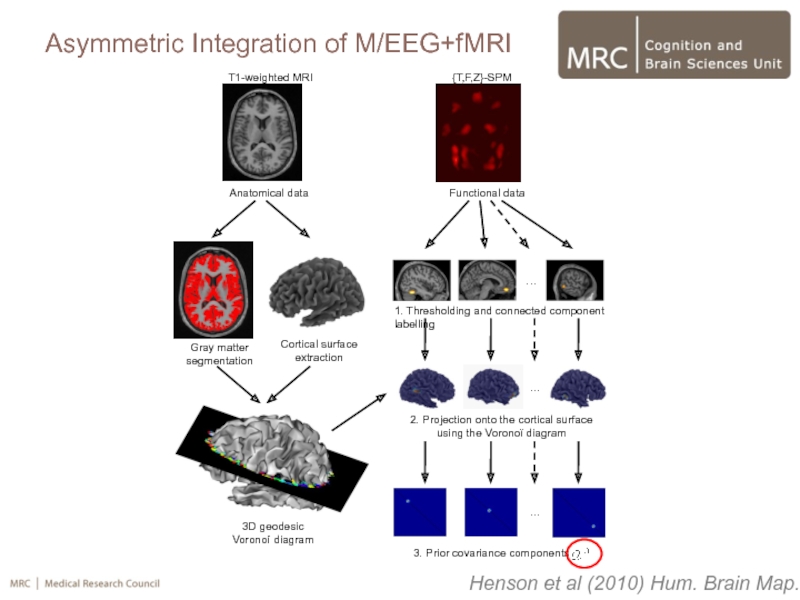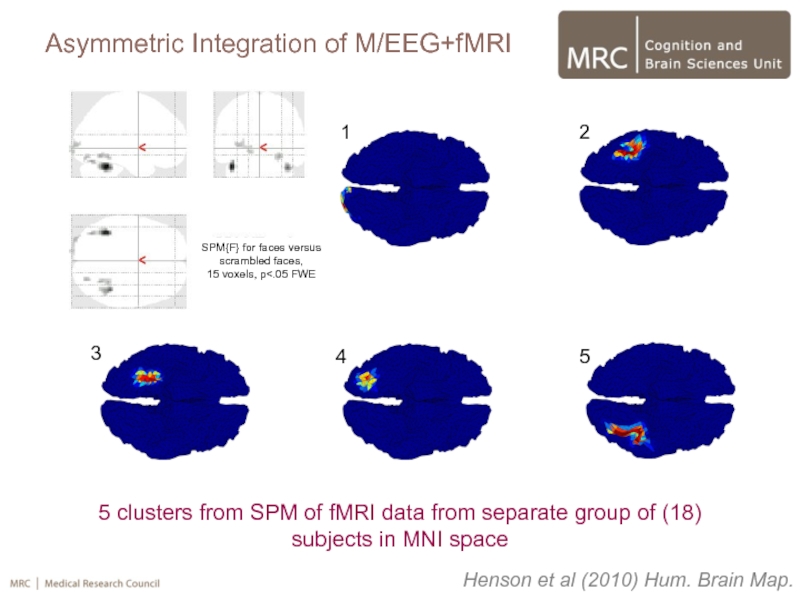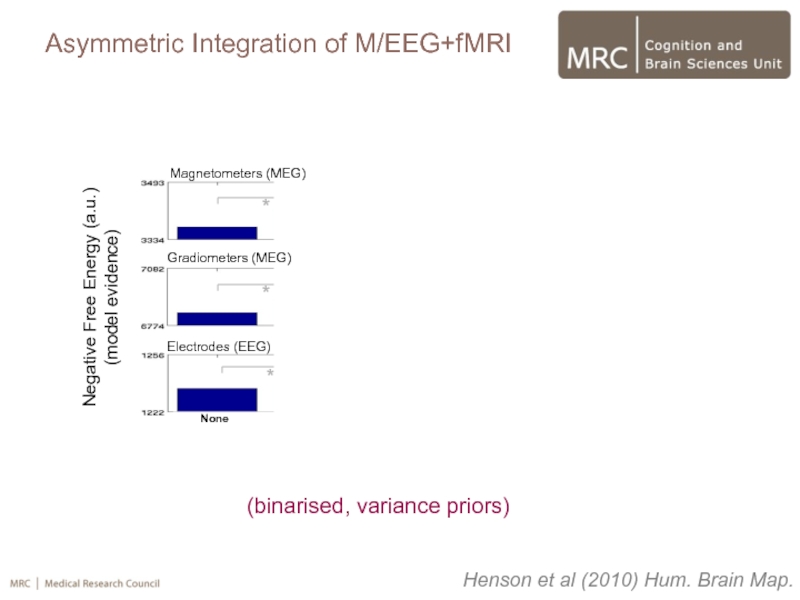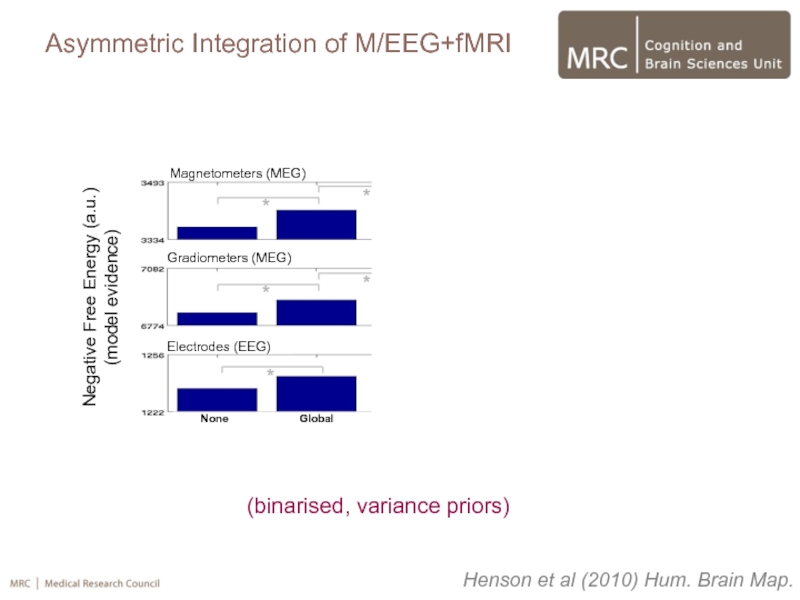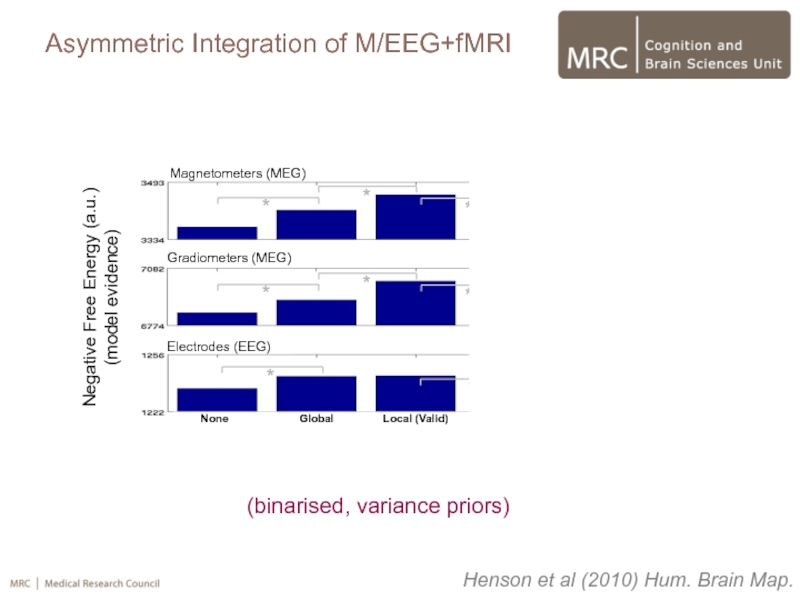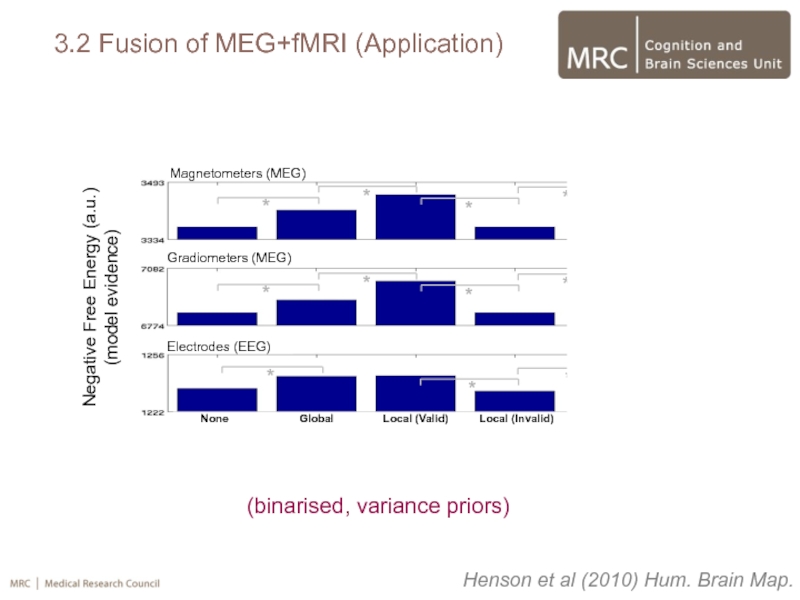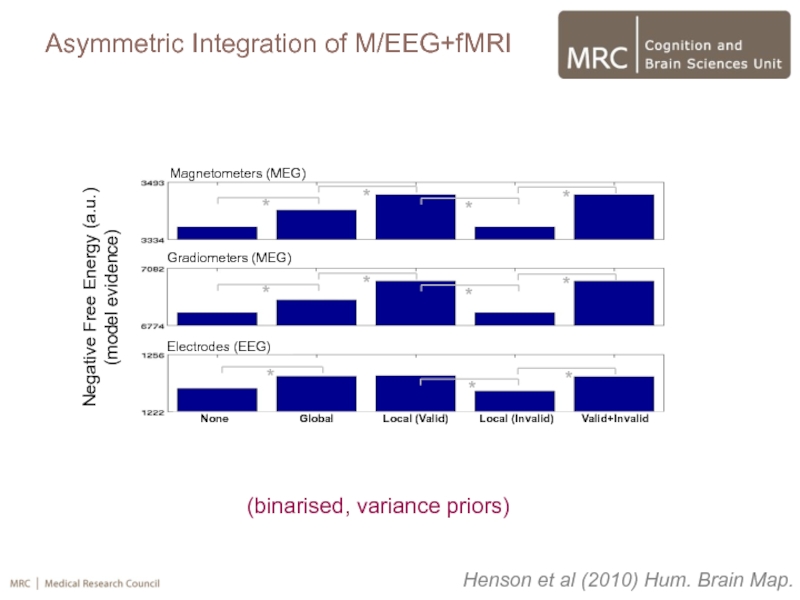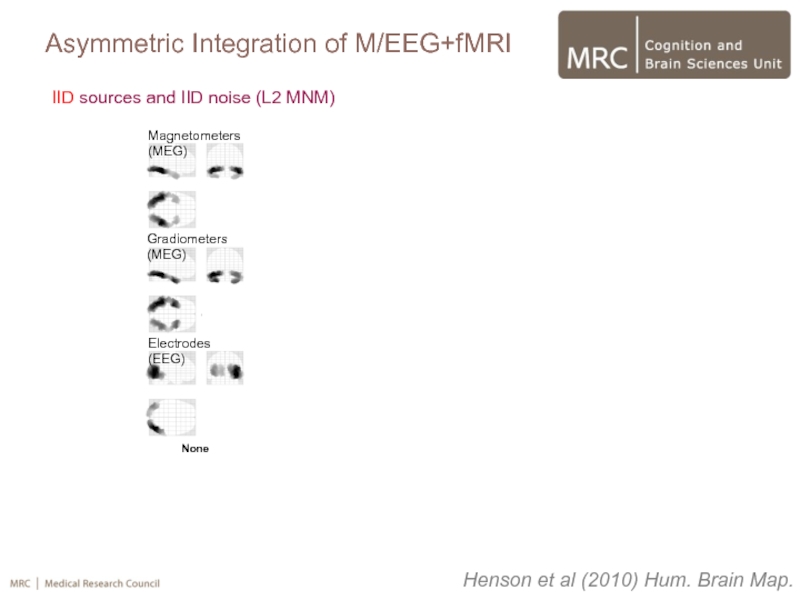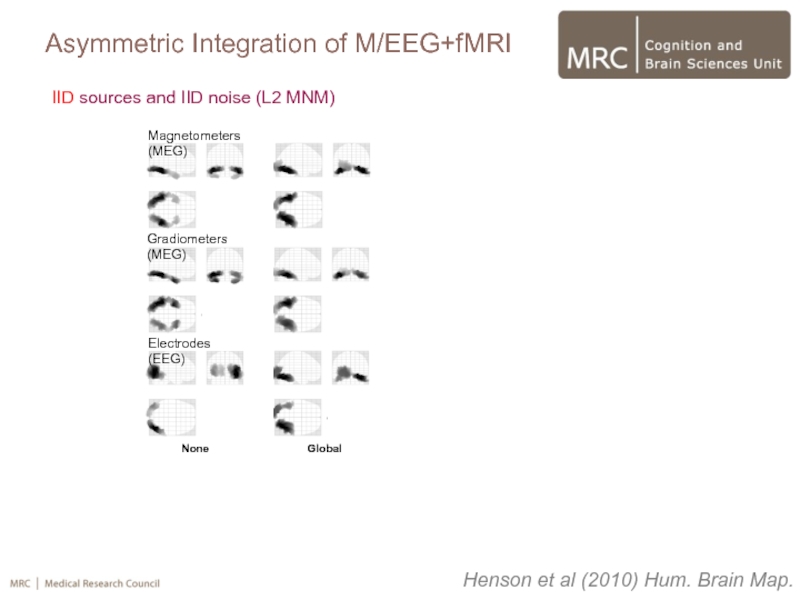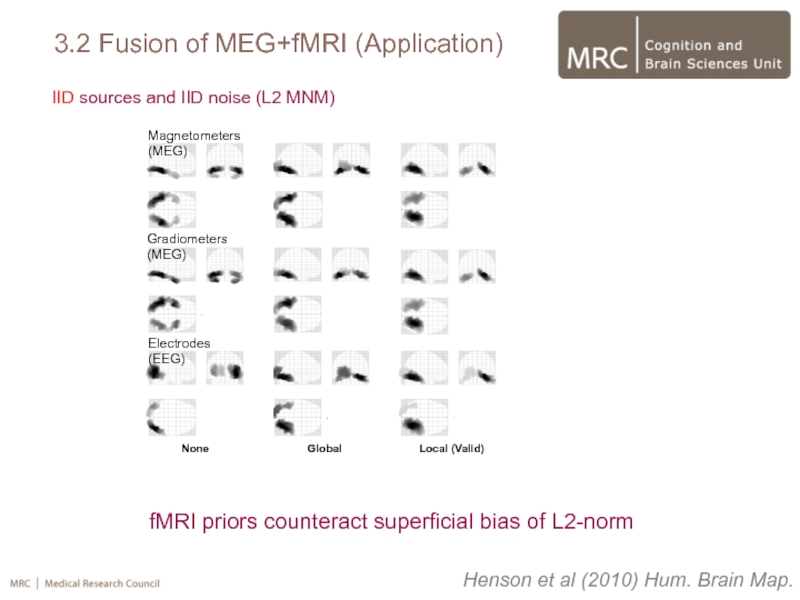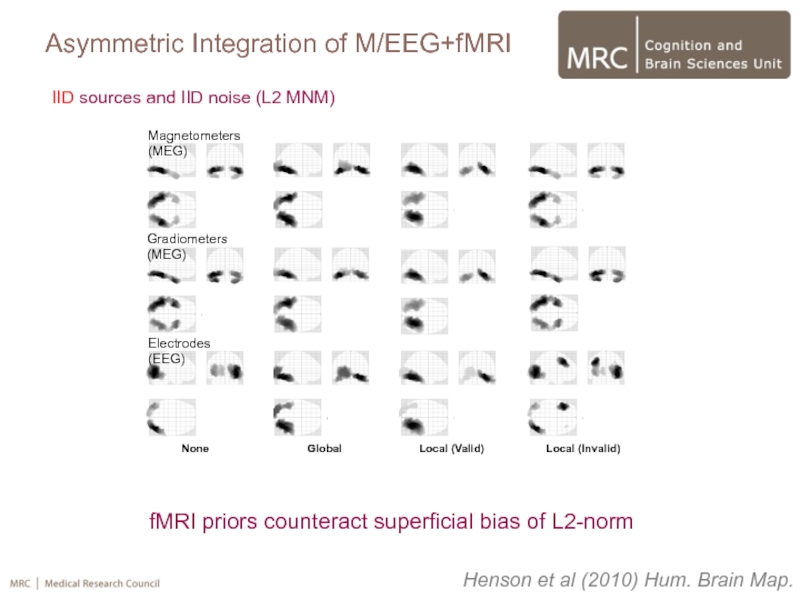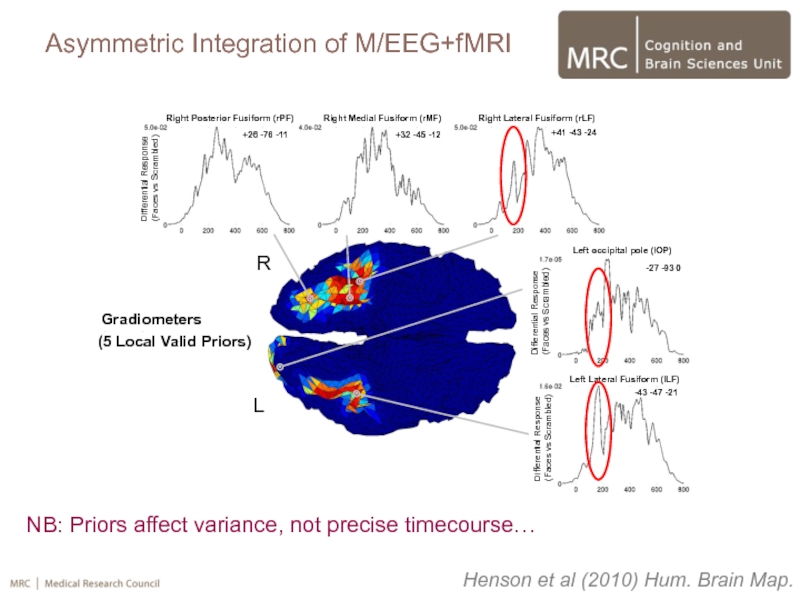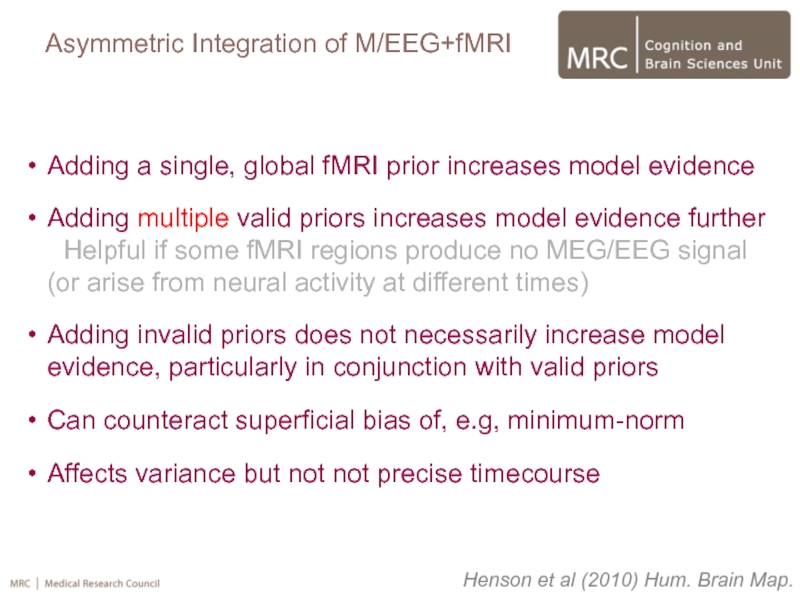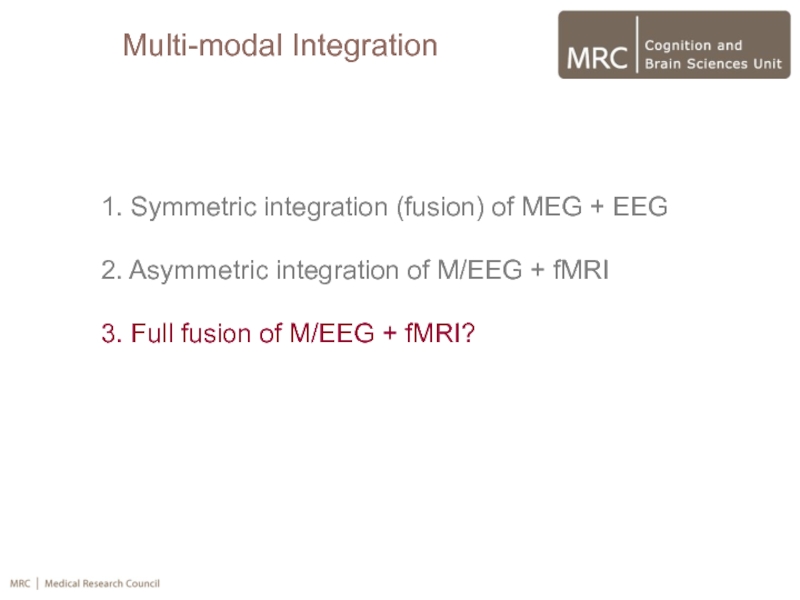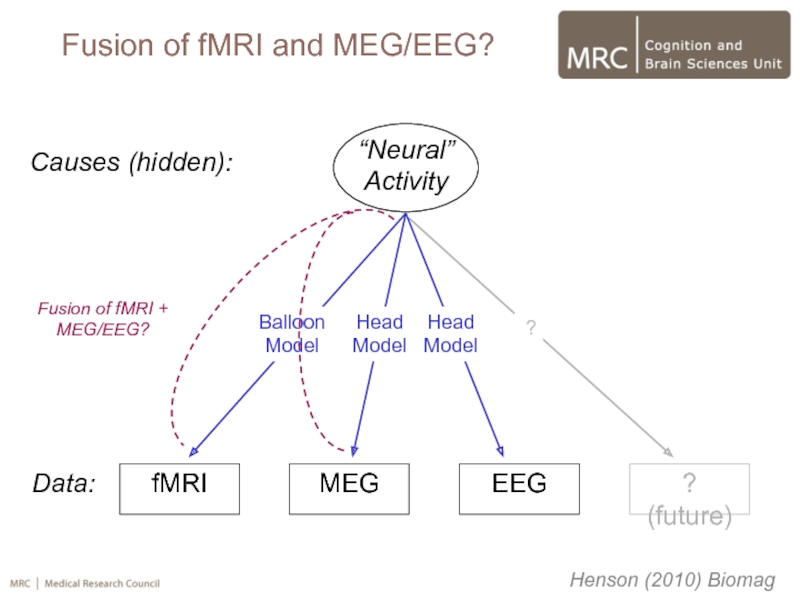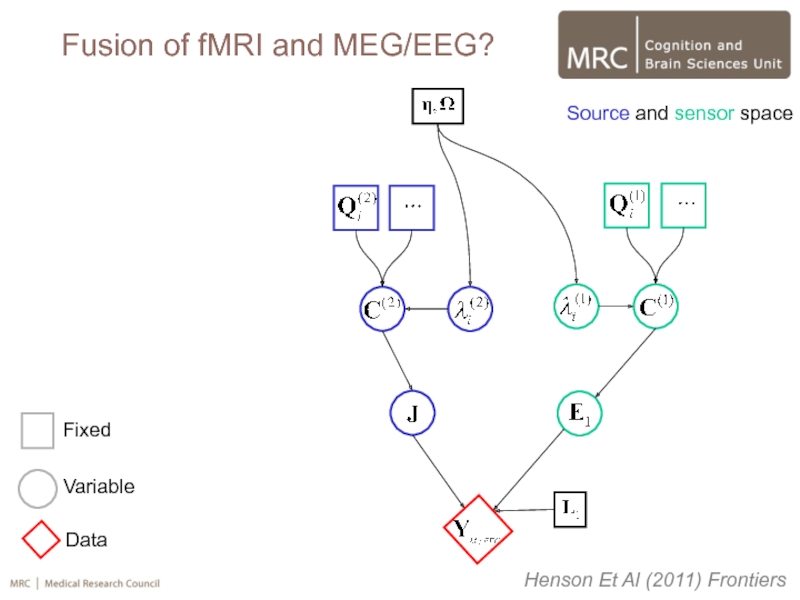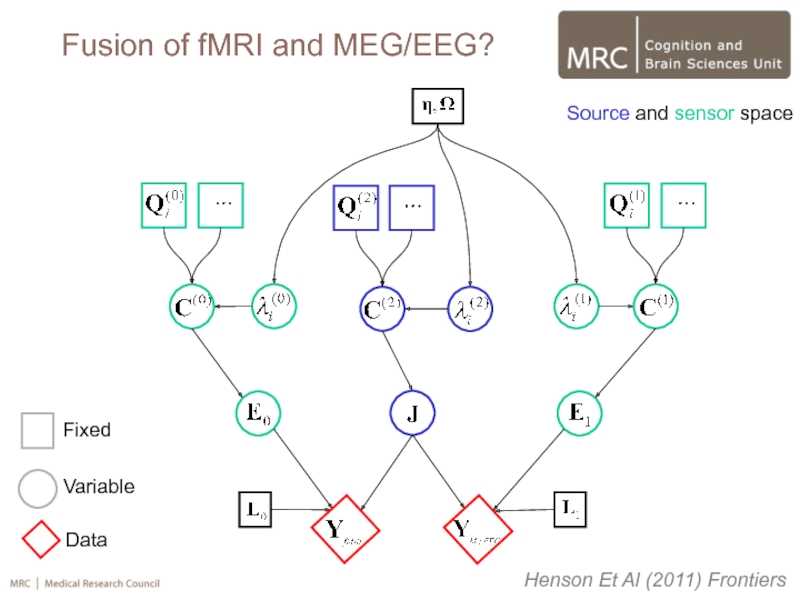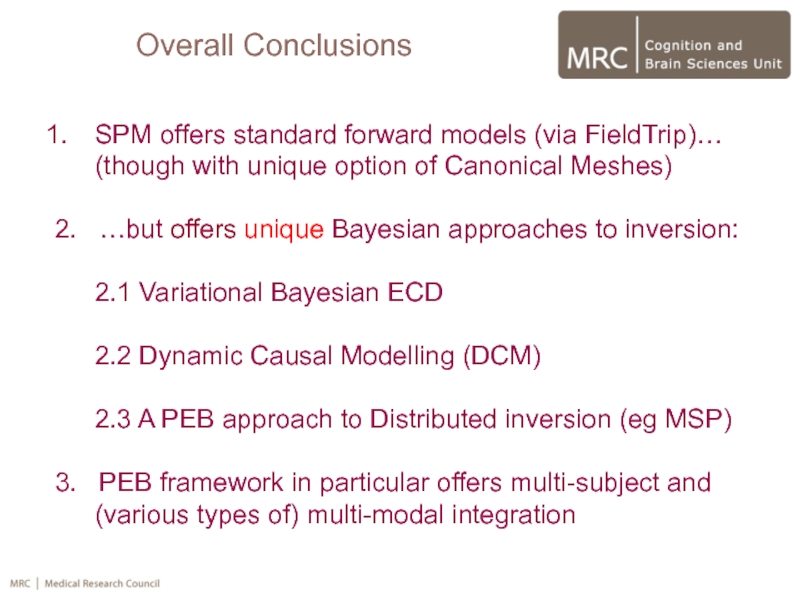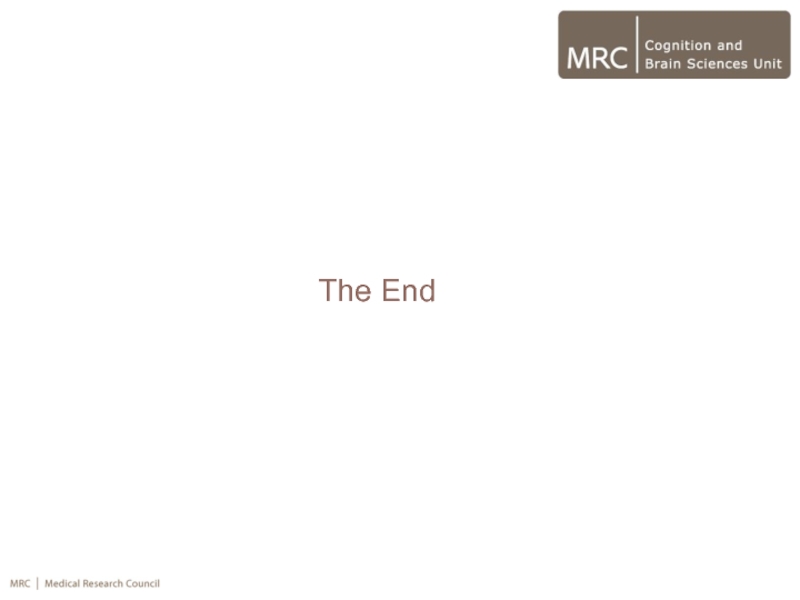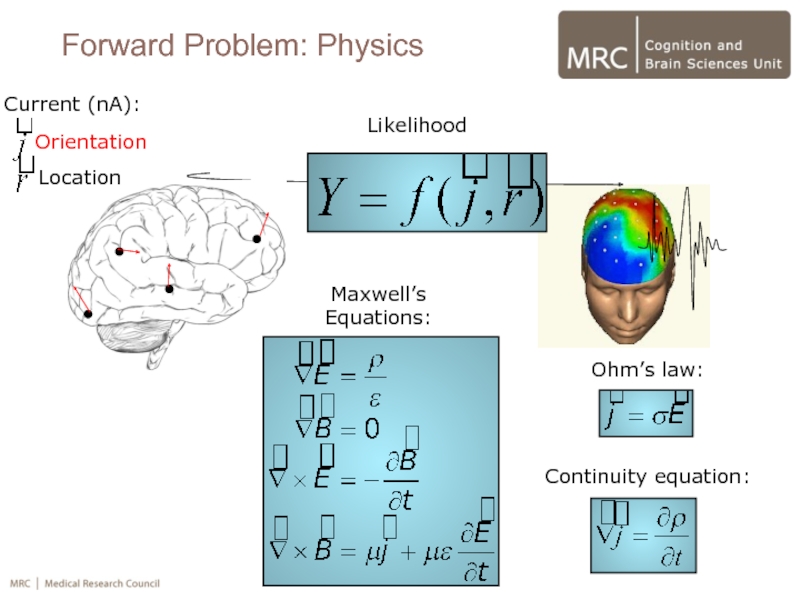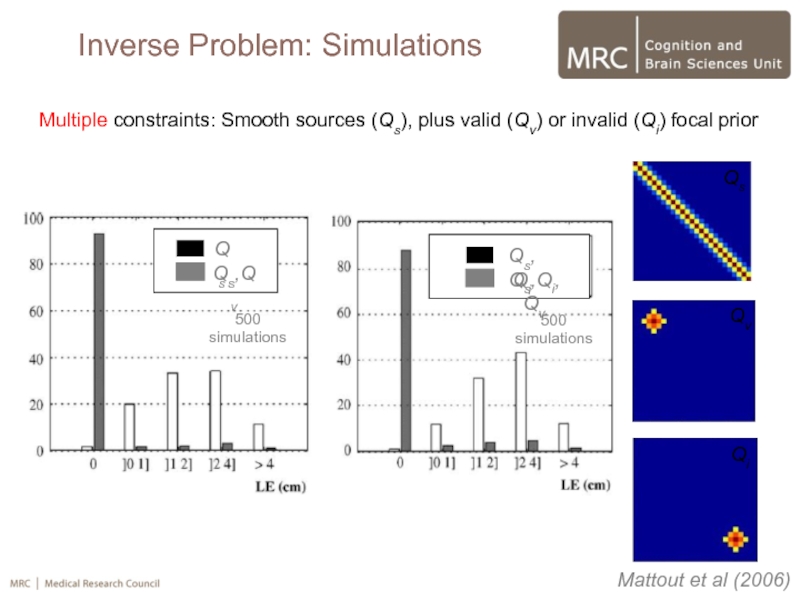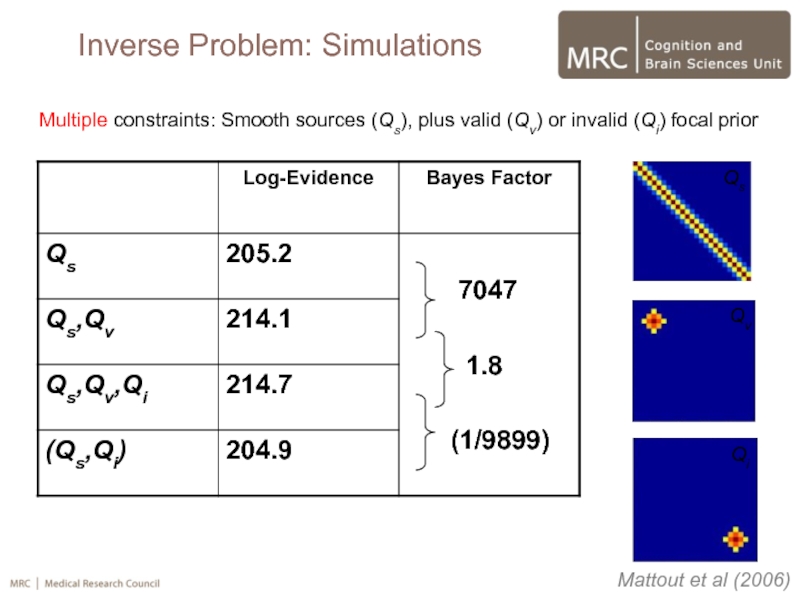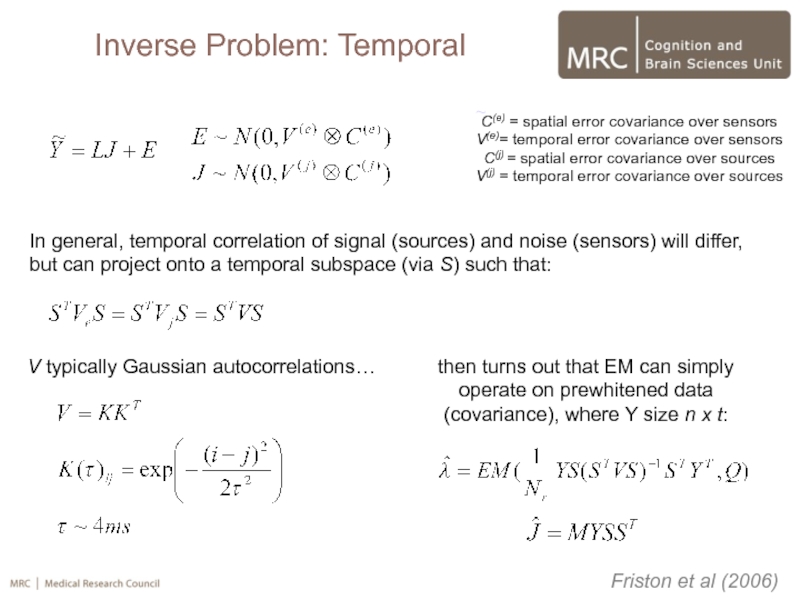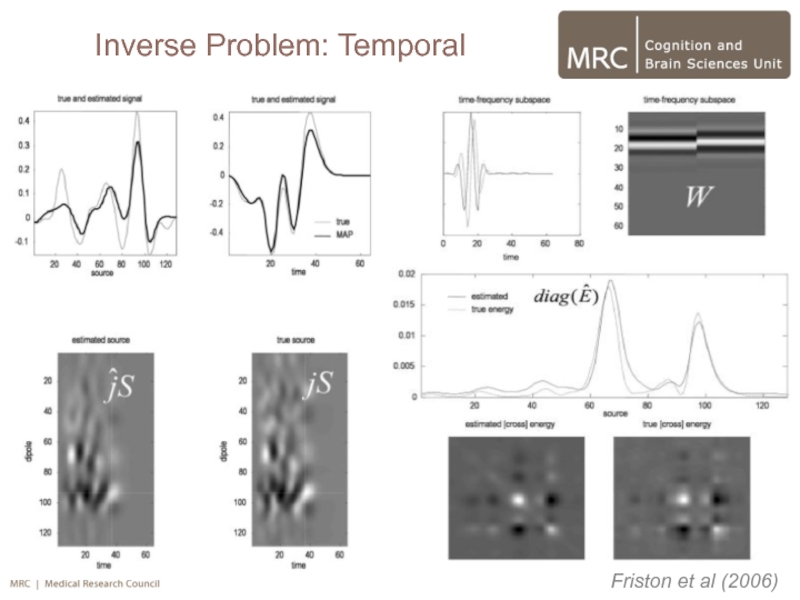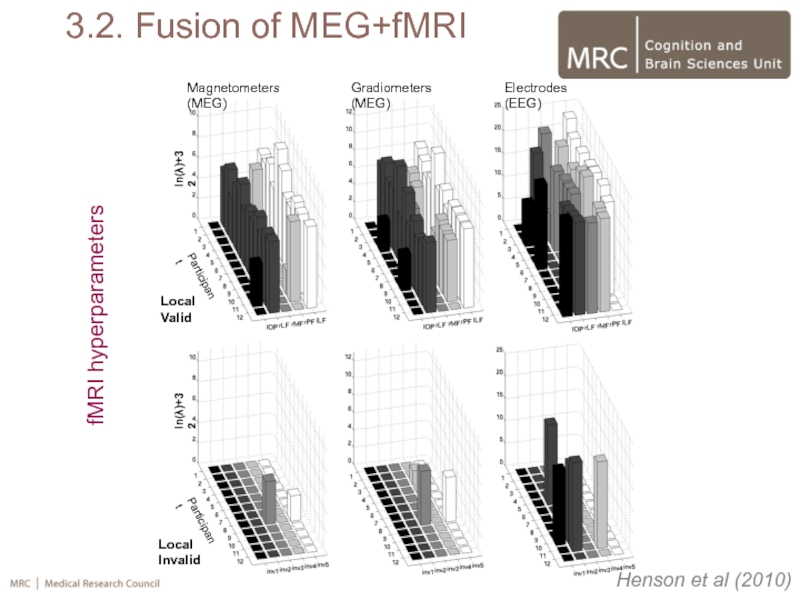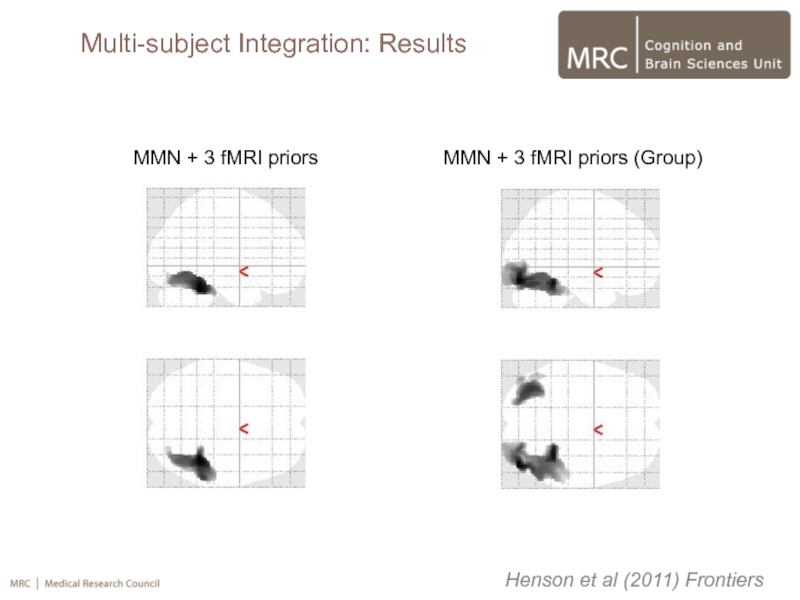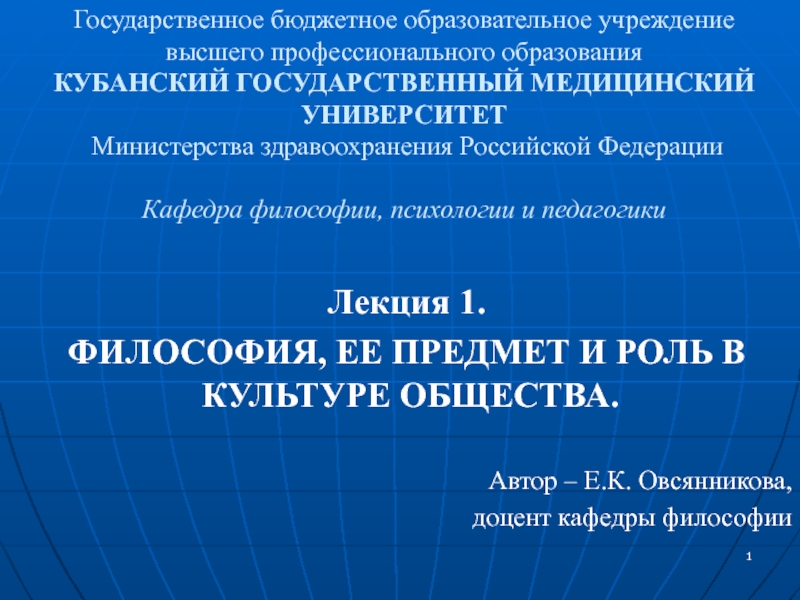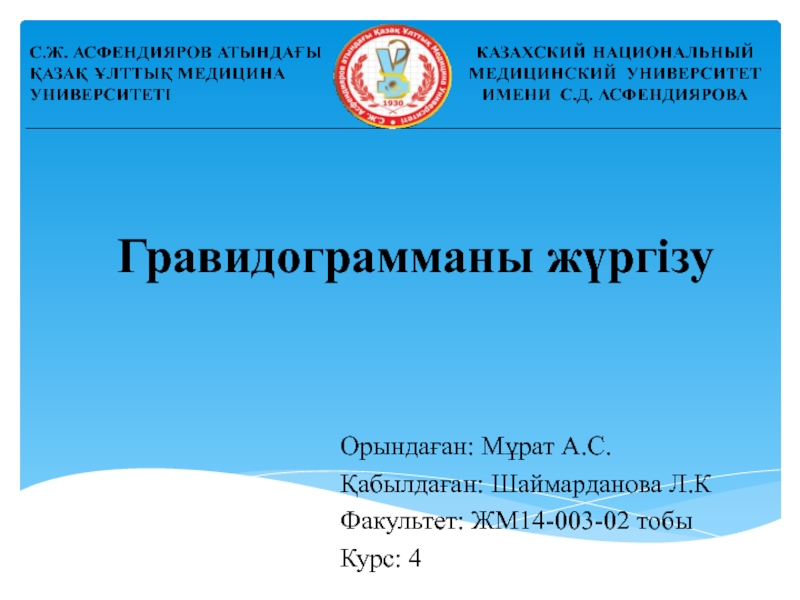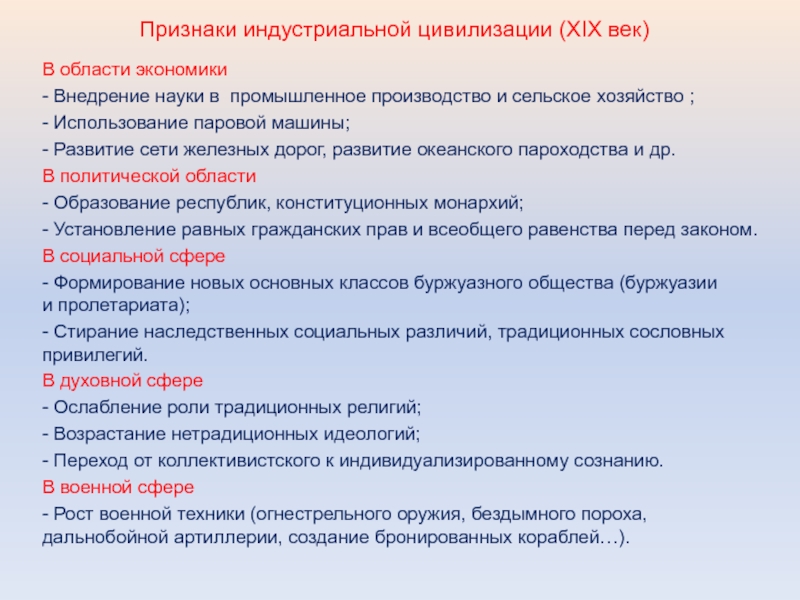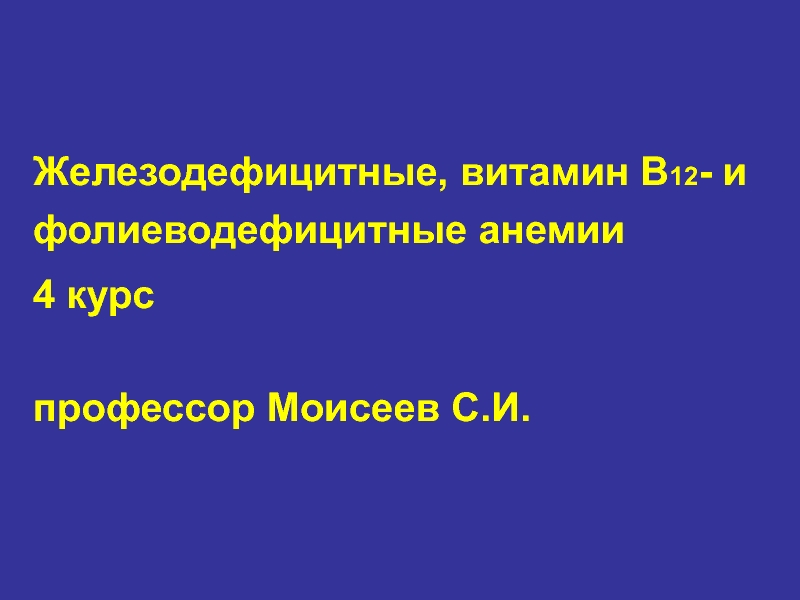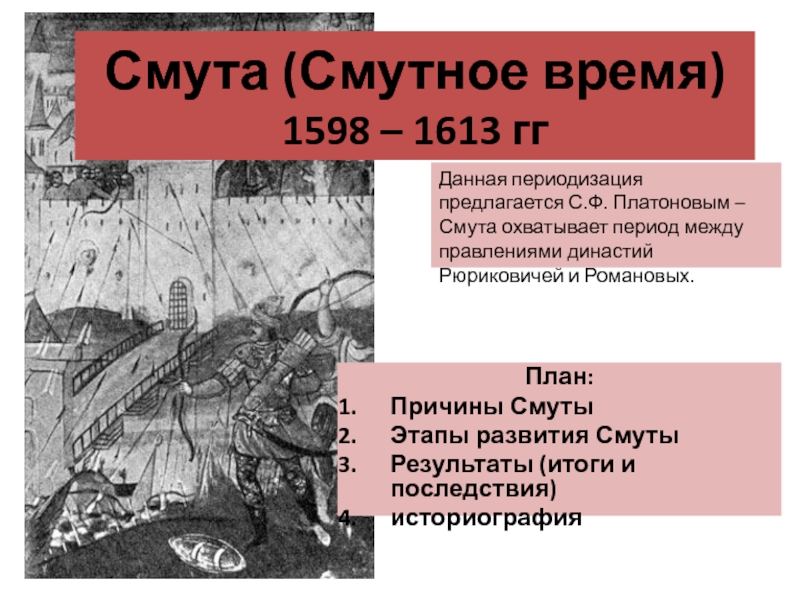Разделы презентаций
- Разное
- Английский язык
- Астрономия
- Алгебра
- Биология
- География
- Геометрия
- Детские презентации
- Информатика
- История
- Литература
- Математика
- Медицина
- Менеджмент
- Музыка
- МХК
- Немецкий язык
- ОБЖ
- Обществознание
- Окружающий мир
- Педагогика
- Русский язык
- Технология
- Физика
- Философия
- Химия
- Шаблоны, картинки для презентаций
- Экология
- Экономика
- Юриспруденция
M/EEG source analysis Rik Henson MRC CBU, Cambridge (with thanks to Christophe
Содержание
- 1. M/EEG source analysis Rik Henson MRC CBU, Cambridge (with thanks to Christophe
- 2. OverviewForward Models for M/EEGVariational Bayesian Dipole Estimation (ECD)Empirical Bayesian Distributed EstimationMultimodal integration
- 3. OverviewForward Models for M/EEGVariational Bayesian Dipole Estimation (ECD)Empirical Bayesian Distributed EstimationMultimodal integration
- 4. Likelihood PriorPosterior EvidenceBayesian PerspectiveForward ProblemInverse ProblemDataParametersModel
- 5. LikelihoodForward Problem: PhysicsKirkoff’s law:Electrical potentialQuasi-staticMaxwell’s Equations:OrientationLocationCurrent density:(EEG)(MEG)
- 6. LikelihoodForward Problem: PhysicsOrientationLocationdepends on: Can have analytic or
- 7. Forward Problem: Head Models Concentric Spheres:Pros: Analytic;
- 8. Forward Problem: Meshes3 important surfaces for BEMs
- 9. Forward Problem: Canonical MeshesRather than extract surfaces
- 10. fMRI time-seriesMotion CorrectAnatomical MRICoregisterDeformationEstimate Spatial NormSpatially normalisedSmoothSmoothedTemplateRecap: (Spatial Normalisation)
- 11. Forward Problem: Canonical MeshesRather than extract surfaces
- 12. LikelihoodForward Problem: ECD vs DistributedOrientationLocationFor small number
- 13. OverviewForward Models for M/EEGVariational Bayesian Dipole Estimation (ECD)Empirical Bayesian Distributed EstimationMultimodal integration
- 14. Inverse Problem: VB-ECDStandard ECD approaches iterate location/orientation
- 15. Inverse Problem: VB-ECDMaximising the (free-energy approximation to
- 16. Inverse Problem: DCMDynamic Causal Modelling (DCM) can
- 17. OverviewForward Models for M/EEGVariational Bayesian Dipole Estimation (ECD)Empirical Bayesian Distributed EstimationMultimodal integration
- 18. Y = Data n sensorsJ = Sources
- 19. Phillips et al (2002), NeuroimageInverse Problem: Standard L2-norm“Minimum Norm”“Loreta” (D=Laplacian)“Depth-Weighted”“Beamformer”“Tikhonov Solution”
- 20. Phillips et al (2005), NeuroimageLikelihood:C(e) = n
- 21. Specifying (co)variance components (priors/regularisation):1. Sensor components,
- 22. Henson et al (2007) NeuroimageWhen multiple Q’s
- 23. Henson et al (2007) NeuroimageWhen multiple Q’s
- 24. Friston et al (2008) NeuroimageFixedVariableDataSource and sensor spaceInverse Problem: Full (DAG) model
- 25. Friston et al (2002) Neuroimage1. Obtain Restricted
- 26. Hyperpriors allow the extreme of 100’s source
- 27. Hyperpriors allow the extreme of 100’s source
- 28. Summary:Automatically “regularises” in principled fashion……allows for multiple
- 29. OverviewForward Models for M/EEGVariational Bayesian Dipole Estimation (ECD)Empirical Bayesian Distributed EstimationMulti-modal and multi-subject integration
- 30. Multi-subject Integration (Group Inversion)Specifying (co)variance components (priors/regularisation):1.
- 31. Specifying (co)variance components (priors/regularisation):1. Sensor components,
- 32. Litvak & Friston (2008) NeuroimageFixedVariableDataSource and sensor spaceMulti-subject Integration (as before)
- 33. Litvak & Friston (2008) NeuroimageFixedVariableDataSource and sensor spaceMulti-subject Integration
- 34. Concatenate data across subjectsCommon source-level priors:Subject-specific sensor-level
- 35. Litvak & Friston (2008) NeuroimageMMNMSPMSP (Group)Multi-subject Integration: Results
- 36. Multi-modal Integration1. Symmetric integration (fusion) of MEG
- 37. fMRIMEG? (future)Data:Causes (hidden):Generative (Forward)Models:BalloonModelHeadModel ? EEGHeadModel“Neural”Activity(inversion)Multi-modal IntegrationDaunizeau et al (2007), Neuroimage
- 38. AsymmetricIntegrationfMRIMEG? (future)Data:Causes (hidden):Generative (Forward)Models:BalloonModelHeadModel ? EEGHeadModel“Neural”ActivitySymmetricIntegration(Fusion)Daunizeau et al (2007), NeuroimageMulti-modal Integration
- 39. Multi-modal Integration1. Symmetric integration (fusion) of MEG
- 40. Specifying (co)variance components (priors/regularisation):1. Sensor components,
- 41. Specifying (co)variance components (priors/regularisation):1. Sensor components,
- 42. Henson et al (2009) NeuroimageFixedVariableDataSource and sensor spaceSingle Modality (as before)
- 43. Henson et al (2009) NeuroimageFixedVariableDataSource and sensor spaceMultiple modalities
- 44. Henson et al (2009) NeuroimageStack data and
- 45. ERs from 12 subjects for 3 simultaneously-acquired
- 46. Слайд 46
- 47. Henson et al (2009) NeuroimageFusing magnetometers, gradiometers
- 48. Multi-modal Integration1. Symmetric integration (fusion) of MEG
- 49. Asymmetric Integration of M/EEG+fMRISpecifying (co)variance components
- 50. Henson et al (2010) Hum. Brain Map.Specifying
- 51. Friston et al (2008) NeuroimageFixedVariableDataSource and sensor spaceAsymmetric Integration of M/EEG+fMRI
- 52. Henson et al (2010) Hum. Brain Map.FixedVariableDataSource and sensor spaceAsymmetric Integration of M/EEG+fMRI
- 53. T1-weighted MRIAnatomical data{T,F,Z}-SPMGray matter segmentationCortical surface
- 54. SPM{F} for faces versus scrambled faces, 15 voxels, p
- 55. (binarised, variance priors)Magnetometers (MEG)****
- 56. (binarised, variance priors)Magnetometers (MEG)****
- 57. (binarised, variance priors)Magnetometers (MEG)****
- 58. 3.2 Fusion of MEG+fMRI (Application)(binarised, variance priors)Magnetometers
- 59. (binarised, variance priors)Magnetometers (MEG)****
- 60. Слайд 60
- 61. Слайд 61
- 62. 3.2 Fusion of MEG+fMRI (Application)fMRI priors counteract
- 63. fMRI priors counteract superficial bias of L2-norm
- 64. Prior 4.Prior 5.NB: Priors affect variance, not
- 65. Adding a single, global fMRI prior increases
- 66. Multi-modal Integration1. Symmetric integration (fusion) of MEG
- 67. Fusion of fMRI and MEG/EEG?fMRIMEG? (future)Data:Causes (hidden):BalloonModelHeadModel ? EEGHeadModel“Neural”ActivityFusion of fMRI + MEG/EEG?Henson (2010) Biomag
- 68. Fusion of fMRI and MEG/EEG?FixedVariableDataSource and sensor spaceHenson Et Al (2011) Frontiers
- 69. Fusion of fMRI and MEG/EEG?Henson Et Al (2011) FrontiersFixedVariableDataSource and sensor space
- 70. Overall ConclusionsSPM offers standard forward models (via
- 71. The End
- 72. LikelihoodForward Problem: PhysicsOhm’s law:Continuity equation:Maxwell’sEquations:OrientationLocationCurrent (nA):
- 73. Inverse Problem: SimulationsMattout et al (2006)Multiple constraints:
- 74. Inverse Problem: SimulationsMattout et al (2006)Multiple constraints:
- 75. Inverse Problem: TemporalFriston et al (2006) V
- 76. Inverse Problem: TemporalFriston et al (2006)
- 77. 3.2. Fusion of MEG+fMRIPrior 4.Prior 5.fMRI hyperparametersln(λ)+32ln(λ)+32ParticipantParticipantMagnetometers (MEG)Gradiometers (MEG)Electrodes (EEG)Local ValidLocal InvalidHenson et al (2010)
- 78. Henson et al (2011) FrontiersMMN + 3 fMRI priorsMMN + 3 fMRI priors (Group)Multi-subject Integration: Results
- 79. Скачать презентанцию
Слайды и текст этой презентации
Слайд 2Overview
Forward Models for M/EEG
Variational Bayesian Dipole Estimation (ECD)
Empirical Bayesian Distributed
Estimation
Multimodal integration
Слайд 3Overview
Forward Models for M/EEG
Variational Bayesian Dipole Estimation (ECD)
Empirical Bayesian Distributed
Estimation
Multimodal integration
Слайд 4Likelihood Prior
Posterior
Evidence
Bayesian Perspective
Forward Problem
Inverse Problem
Data
Parameters
Model
Слайд 5Likelihood
Forward Problem: Physics
Kirkoff’s law:
Electrical potential
Quasi-static
Maxwell’s Equations:
Orientation
Location
Current density:
(EEG)
(MEG)
Слайд 6Likelihood
Forward Problem: Physics
Orientation
Location
depends on:
Can have analytic or numerical form…
location (orientation)
of sensors
geometry of head
conductivity of head
(source space)
Слайд 7Forward Problem: Head Models
Concentric Spheres:
Pros: Analytic; Fast to compute
Cons:
Head not spherical; Conductivity not homogeneous
Boundary (or Finite) Element Models:
Pros: Realistic
geometryHomogeneous conductivity within boundaries
Cons: Numeric; Slow
Approximation Errors
Other approaches (for MEG): Fit local spheres to each sensor;
Single shell, spherical approx (Nolte)
Слайд 8Forward Problem: Meshes
3 important surfaces for BEMs are those with
large changes in conductivity:
Scalp (skin-air boundary)
Outer Skull (bone-skin boundary)
Inner Skull
(CSF-bone boundary)(Represented as tessellated triangular meshes)
Extracting these surfaces from an MRI is difficult, eg, because CSF-bone T1-contrast is poor (use PD?)…
A fourth important surface (for some solutions) is:
Cortex (WM-GM boundary)
Extracting this surface from an MRI is very difficult because so convoluted (though FreeSurfer)…
Слайд 9Forward Problem: Canonical Meshes
Rather than extract surfaces from individuals MRIs,
why not warp Template surfaces from an MNI brain based
on spatial (inverse) normalisation?Henson et al (2009), Neuroimage
Слайд 10fMRI time-series
Motion Correct
Anatomical MRI
Coregister
Deformation
Estimate Spatial Norm
Spatially normalised
Smooth
Smoothed
Template
Recap: (Spatial Normalisation)
Слайд 11Forward Problem: Canonical Meshes
Rather than extract surfaces from individuals MRIs,
why not warp Template surfaces from an MNI brain based
on spatial (inverse) normalisation?“Canonical”
(Also provides a 1-to-1 mapping across subjects, so source solutions can be written directly to MNI space, and group-inversion applied; see later)
Given that surfaces are part of the forward model (m), can use the model evidence to determine whether Canonical Meshes are sufficient
Henson et al (2009), Neuroimage
Mattout et al (2007), Comp Int & Neuro
Individual Canonical Template
(Inverse-Normalised)
Слайд 12Likelihood
Forward Problem: ECD vs Distributed
Orientation
Location
For small number of Equivalent Current
Dipoles (ECD) anywhere in brain:
is linear in but
non-linear in For (large) number of (Distributed) dipoles with fixed orientation and location:
is linear in
Слайд 13Overview
Forward Models for M/EEG
Variational Bayesian Dipole Estimation (ECD)
Empirical Bayesian Distributed
Estimation
Multimodal integration
Слайд 14Inverse Problem: VB-ECD
Standard ECD approaches iterate location/orientation (within a brain
volume) until fit to sensor data is maximised (i.e, error
minimised). But:Local Minima (particularly when multiple dipoles)
Question of how many dipoles?
With a Variational Bayesian (VB) framework, priors can be put on the locations and orientations (and strengths) of dipoles (e.g, symmetry constraints)
Kiebel et al (2008), Neuroimage
Слайд 15Inverse Problem: VB-ECD
Maximising the (free-energy approximation to the) model evidence
offers a natural answer to question of the number of
dipolesKiebel et al (2008), Neuroimage
Слайд 16Inverse Problem: DCM
Dynamic Causal Modelling (DCM) can be seen as
a source localisation (inverse) method that includes temporal constraints on
the source activitiesDavid et al (2011), Journal of Neuroscience
Слайд 17Overview
Forward Models for M/EEG
Variational Bayesian Dipole Estimation (ECD)
Empirical Bayesian Distributed
Estimation
Multimodal integration
Слайд 18Y = Data n sensors
J = Sources p>>n sources
L =
Leadfields n sensors x p sources
E = Error
n sensors……draw from Gaussian covariance C(e)
…linear Forward Model for MEG/EEG:
Fact that p>>n means under-determined problem (cf. GLM and ECD)…
…so some form of regularisation needed, e.g,“Weighted L2-norm”…
Inverse Problem: Distributed
Given p sources fixed in location (e.g, on a cortical mesh)…
(Free orientations can be simulated by having 2-3 columns in L per location)
Слайд 19Phillips et al (2002), Neuroimage
Inverse Problem: Standard L2-norm
“Minimum Norm”
“Loreta” (D=Laplacian)
“Depth-Weighted”
“Beamformer”
“Tikhonov
Solution”
Слайд 20Phillips et al (2005), Neuroimage
Likelihood:
C(e) = n x n Sensor
(error) covariance
Prior:
C(j) = p x p Source (prior) covariance
Posterior:
Inverse Problem:
Equivalent PEBParametric Empirical Bayesian (PEB) 2-level hierarchical form:
Maximum A Posteriori (MAP) estimate:
cf Classical Tikhonov:
Слайд 21Specifying (co)variance components (priors/regularisation):
1. Sensor components, (error):
C
= Sensor/Source covariance
Q = Covariance components
λ = Hyper-parameters
2. Source components,
(priors/regularisation):“IID” (white noise):
Empty-room:
“IID” (min norm):
Multiple Sparse
Priors (MSP):
Friston et al (2008) Neuroimage
Inverse Problem:
Covariance Components (Priors)
Слайд 22Henson et al (2007) Neuroimage
When multiple Q’s are correlated, estimation
of hyperparameters λ can be difficult (eg local maxima), and
they can become negative (improper for covariances)To overcome this, one can:
uninformative priors are then “turned-off” (cf. “Automatic Relevance Detection”)
1) impose positivity on hyperparameters:
2) impose weak, shrinkage hyperpriors:
Inverse Problem: HyperPriors
Слайд 23Henson et al (2007) Neuroimage
When multiple Q’s are correlated, estimation
of hyperparameters λ can be difficult (eg local maxima), and
they can become negative (improper for covariances)To overcome this, one can:
uninformative priors are then “turned-off” (cf. “Automatic Relevance Detection”)
1) impose positivity on hyperparameters:
2) impose weak, shrinkage hyperpriors:
Inverse Problem: HyperPriors
Слайд 24Friston et al (2008) Neuroimage
Fixed
Variable
Data
Source and sensor space
Inverse Problem: Full
(DAG) model
Слайд 25Friston et al (2002) Neuroimage
1. Obtain Restricted Maximum Likelihood (ReML)
estimates of the hyperparameters (λ) by maximising the variational “free
energy” (F):2. Obtain Maximum A Posteriori (MAP) estimates of parameters (sources, J):
3. Maximal F approximates Bayesian (log) “model evidence” for a model, m:
Complexity
(…where and are the posterior mean and covariance of hyperparameters)
Accuracy
Inverse Problem: Estimation
Слайд 26Hyperpriors allow the extreme of 100’s source priors, or MSP
Inverse
Problem: Multiple Sparse Priors
…
Friston et al (2008) Neuroimage
Слайд 27Hyperpriors allow the extreme of 100’s source priors, or MSP
Inverse
Problem: Multiple Sparse Priors
Friston et al (2008) Neuroimage
Слайд 28Summary:
Automatically “regularises” in principled fashion…
…allows for multiple constraints (priors)…
…to the
extent that multiple (100’s) of sparse priors possible (MSP)…
…(or multiple
error components or multiple fMRI priors)……furnishes estimates of model evidence, so can compare constraints
Inverse Problem: PEB Summary
Слайд 29Overview
Forward Models for M/EEG
Variational Bayesian Dipole Estimation (ECD)
Empirical Bayesian Distributed
Estimation
Multi-modal and multi-subject integration
Слайд 30Multi-subject Integration (Group Inversion)
Specifying (co)variance components (priors/regularisation):
1. Sensor components,
(error):
C = Sensor/Source covariance
Q = Covariance components
λ =
Hyper-parameters2. Source components, (priors/regularisation):
“IID” (white noise):
Empty-room:
“IID” (min norm):
Multiple Sparse
Priors (MSP):
Friston et al (2008) Neuroimage
Слайд 31Specifying (co)variance components (priors/regularisation):
1. Sensor components, (error):
C
= Sensor/Source covariance
Q = Covariance components
λ = Hyper-parameters
“IID” (white noise):
Empty-room:
2.
Optimise Multiple Sparse Priors by pooling across subjectsLitvak & Friston (2008) Neuroimage
Multi-subject Integration (Group Inversion)
Слайд 32Litvak & Friston (2008) Neuroimage
Fixed
Variable
Data
Source and sensor space
Multi-subject Integration (as
before)
Слайд 33Litvak & Friston (2008) Neuroimage
Fixed
Variable
Data
Source and sensor space
Multi-subject Integration
Слайд 34Concatenate data across subjects
Common source-level priors:
Subject-specific sensor-level priors:
Litvak & Friston
(2008) Neuroimage
…having projected to an “average” leadfield matrix
Multi-subject Integration: Leadfield
AlignmentСлайд 36Multi-modal Integration
1. Symmetric integration (fusion) of MEG + EEG
2. Asymmetric
integration of M/EEG + fMRI
3. Full fusion of M/EEG +
fMRI?Слайд 37fMRI
MEG
? (future)
Data:
Causes (hidden):
Generative (Forward)
Models:
Balloon
Model
Head
Model
?
EEG
Head
Model
“Neural”
Activity
(inversion)
Multi-modal Integration
Daunizeau et al (2007),
Neuroimage
Слайд 38Asymmetric
Integration
fMRI
MEG
? (future)
Data:
Causes (hidden):
Generative (Forward)
Models:
Balloon
Model
Head
Model
?
EEG
Head
Model
“Neural”
Activity
Symmetric
Integration
(Fusion)
Daunizeau et al (2007), Neuroimage
Multi-modal
Integration
Слайд 39Multi-modal Integration
1. Symmetric integration (fusion) of MEG + EEG
2. Asymmetric
integration of M/EEG + fMRI
3. Full fusion of M/EEG +
fMRI?Слайд 40Specifying (co)variance components (priors/regularisation):
1. Sensor components, (error):
C
= Sensor/Source covariance
Q = Covariance components
λ = Hyper-parameters
2. Source components,
(priors/regularisation):“IID” (white noise):
Empty-room:
“IID” (min norm):
Multiple Sparse
Priors (MSP):
Friston et al (2008) Neuroimage
Symmetric Integration of MEG+EEG
Слайд 41Specifying (co)variance components (priors/regularisation):
1. Sensor components, (error):
Ci(e) =
Sensor error covariance for ith modality
Qij = jth component for
ith modalityλij = Hyper-parameters
2. Source components, (priors/regularisation):
“IID” (min norm):
Multiple Sparse
Priors (MSP):
E.g, white noise for 2 modalities:
Henson et al (2009) Neuroimage
Symmetric Integration of MEG+EEG
Слайд 42Henson et al (2009) Neuroimage
Fixed
Variable
Data
Source and sensor space
Single Modality (as
before)
Слайд 44Henson et al (2009) Neuroimage
Stack data and leadfields for d
modalities:
Where data / leadfields scaled to have same average /
predicted variance:mi = Number of spatial modes
(e.g, ~70% of #sensors)
(note: common sources and source priors, but separate error components)
Symmetric Integration of MEG+EEG
Слайд 45ERs from 12 subjects for 3 simultaneously-acquired Neuromag sensor-types:
RMS fT/m
μV
Faces
Scrambled
fT
Magnetometers
(MEG, 102)
(Planar) Gradiometers
(MEG, 204)
Electrodes
(EEG, 70)
Henson et al (2009)
Neuroimage150-190ms
Faces - Scrambled
ms
ms
ms
Symmetric Integration of MEG+EEG
Слайд 46
MEG mags
MEG grads EEG
FUSED
+31 -51 -15
+19 -48 -6
+43 -67 -11
+44 -64 -4
Henson et al (2009) Neuroimage
IID noise for each modality; common MSP for sources
(fixed number of spatial+temporal modes)
Scrambled
150-190ms
Faces – Scrambled,
Faces
Symmetric Integration of MEG+EEG
Слайд 47Henson et al (2009) Neuroimage
Fusing magnetometers, gradiometers and EEG increased
the conditional precision of the source estimates relative to inverting
any one modality alone(when equating number of spatial+temporal modes)
The maximal sources recovered from fusion were a plausible combination of the ventral temporal sources recovered by MEG and the lateral temporal sources recovered by EEG
(Simulations show the relative scaling of mags and grads agrees with empty-room data)
Symmetric Integration of MEG+EEG
Слайд 48Multi-modal Integration
1. Symmetric integration (fusion) of MEG + EEG
2. Asymmetric
integration of M/EEG + fMRI
3. Full fusion of M/EEG +
fMRI?Слайд 49 Asymmetric Integration of M/EEG+fMRI
Specifying (co)variance components (priors/regularisation):
1. Sensor components,
(error):
C = Sensor/Source covariance
Q = Covariance components
λ
= Hyper-parameters2. Source components, (priors/regularisation):
“IID” (white noise):
Empty-room:
“IID” (min norm):
Multiple Sparse
Priors (MSP):
Friston et al (2008) Neuroimage
Слайд 50Henson et al (2010) Hum. Brain Map.
Specifying (co)variance components (priors/regularisation):
1.
Sensor components, (error):
C = Sensor/Source covariance
Q =
Covariance componentsλ = Hyper-parameters
“IID” (white noise):
Empty-room:
“IID” (min norm):
fMRI Priors:
# sources
# sources
2. Each suprathreshold fMRI cluster becomes a separate prior
Asymmetric Integration of M/EEG+fMRI
Слайд 51Friston et al (2008) Neuroimage
Fixed
Variable
Data
Source and sensor space
Asymmetric Integration of
M/EEG+fMRI
Слайд 52Henson et al (2010) Hum. Brain Map.
Fixed
Variable
Data
Source and sensor space
Asymmetric
Integration of M/EEG+fMRI
Слайд 53T1-weighted MRI
Anatomical data
{T,F,Z}-SPM
Gray matter
segmentation
Cortical surface
extraction
3D geodesic
Voronoï diagram
Functional data
…
1. Thresholding
and connected component labelling
…
2. Projection onto the cortical surface
using
the Voronoï diagram…
3. Prior covariance components
Henson et al (2010) Hum. Brain Map.
Asymmetric Integration of M/EEG+fMRI
Слайд 54SPM{F} for faces versus scrambled faces,
15 voxels, p
clusters from SPM of fMRI data from separate group of
(18) subjects in MNI space1
2
3
4
5
Henson et al (2010) Hum. Brain Map.
Asymmetric Integration of M/EEG+fMRI
Слайд 55(binarised, variance priors)
Magnetometers (MEG)
*
*
*
*
None Global Local (Valid) Local (Invalid) Valid+Invalid
Electrodes (EEG)
Negative Free Energy (a.u.)
(model evidence)
*
*
*
*
*
*
*
Gradiometers (MEG)
Henson et al (2010) Hum. Brain Map.
Asymmetric Integration of M/EEG+fMRI
Слайд 56(binarised, variance priors)
Magnetometers (MEG)
*
*
*
*
Gradiometers (MEG)
None Global Local (Valid) Local (Invalid) Valid+Invalid
Electrodes (EEG)
Negative Free Energy (a.u.)
(model evidence)
*
*
*
*
*
*
*
Henson et al (2010) Hum. Brain Map.
Asymmetric Integration of M/EEG+fMRI
Слайд 57(binarised, variance priors)
Magnetometers (MEG)
*
*
*
*
Gradiometers (MEG)
None Global Local (Valid) Local (Invalid) Valid+Invalid
Electrodes (EEG)
Negative Free Energy (a.u.)
(model evidence)
*
*
*
*
*
*
*
Henson et al (2010) Hum. Brain Map.
Asymmetric Integration of M/EEG+fMRI
Слайд 583.2 Fusion of MEG+fMRI (Application)
(binarised, variance priors)
Magnetometers (MEG)
*
*
*
*
Gradiometers (MEG)
None Global Local (Valid) Local (Invalid) Valid+Invalid
Electrodes (EEG)
Negative Free Energy (a.u.)
(model evidence)
*
*
*
*
*
*
*
Henson et al (2010) Hum. Brain Map.
Слайд 59(binarised, variance priors)
Magnetometers (MEG)
*
*
*
*
Gradiometers (MEG)
None Global Local (Valid) Local (Invalid) Valid+Invalid
Electrodes (EEG)
Negative Free Energy (a.u.)
(model evidence)
*
*
*
*
*
*
*
Henson et al (2010) Hum. Brain Map.
Asymmetric Integration of M/EEG+fMRI
Слайд 60 None
Global Local (Valid) Local (Invalid)
Magnetometers (MEG)
Gradiometers (MEG)
Electrodes (EEG)
IID sources and IID noise (L2 MNM)
Henson et al (2010) Hum. Brain Map.
Asymmetric Integration of M/EEG+fMRI
Слайд 61 None
Global Local (Valid) Local (Invalid)
Magnetometers (MEG)
Gradiometers (MEG)
Electrodes (EEG)
IID sources and IID noise (L2 MNM)
Henson et al (2010) Hum. Brain Map.
Asymmetric Integration of M/EEG+fMRI
Слайд 623.2 Fusion of MEG+fMRI (Application)
fMRI priors counteract superficial bias of
L2-norm
None
Global Local (Valid) Local (Invalid) Magnetometers (MEG)
Gradiometers (MEG)
Electrodes (EEG)
IID sources and IID noise (L2 MNM)
Henson et al (2010) Hum. Brain Map.
Слайд 63fMRI priors counteract superficial bias of L2-norm
None
Global Local (Valid) Local (Invalid)Magnetometers (MEG)
Gradiometers (MEG)
Electrodes (EEG)
IID sources and IID noise (L2 MNM)
Henson et al (2010) Hum. Brain Map.
Asymmetric Integration of M/EEG+fMRI
Слайд 64Prior 4.
Prior 5.
NB: Priors affect variance, not precise timecourse…
R
L
Gradiometers (MEG)
(5
Local Valid Priors)
Differential Response
(Faces vs Scrambled)
Differential Response
(Faces vs
Scrambled)Right Posterior Fusiform (rPF) Right Medial Fusiform (rMF) Right Lateral Fusiform (rLF)
Left occipital pole (lOP)
-27 -93 0
+26 -76 -11
+41 -43 -24
+32 -45 -12
-43 -47 -21
Left Lateral Fusiform (lLF)
Differential Response
(Faces vs Scrambled)
Henson et al (2010) Hum. Brain Map.
Asymmetric Integration of M/EEG+fMRI
Слайд 65Adding a single, global fMRI prior increases model evidence
Adding multiple
valid priors increases model evidence further
Helpful if some fMRI regions
produce no MEG/EEG signal (or arise from neural activity at different times)Adding invalid priors does not necessarily increase model evidence, particularly in conjunction with valid priors
Can counteract superficial bias of, e.g, minimum-norm
Affects variance but not not precise timecourse
Henson et al (2010) Hum. Brain Map.
Asymmetric Integration of M/EEG+fMRI
Слайд 66Multi-modal Integration
1. Symmetric integration (fusion) of MEG + EEG
2. Asymmetric
integration of M/EEG + fMRI
3. Full fusion of M/EEG +
fMRI?Слайд 67 Fusion of fMRI and MEG/EEG?
fMRI
MEG
? (future)
Data:
Causes (hidden):
Balloon
Model
Head
Model
?
EEG
Head
Model
“Neural”
Activity
Fusion
of fMRI + MEG/EEG?
Henson (2010) Biomag
Слайд 68 Fusion of fMRI and MEG/EEG?
Fixed
Variable
Data
Source and sensor space
Henson Et
Al (2011) Frontiers
Слайд 69 Fusion of fMRI and MEG/EEG?
Henson Et Al (2011) Frontiers
Fixed
Variable
Data
Source
and sensor space
Слайд 70Overall Conclusions
SPM offers standard forward models (via FieldTrip)…
(though with unique
option of Canonical Meshes)
2. …but offers unique Bayesian approaches
to inversion:2.1 Variational Bayesian ECD
2.2 Dynamic Causal Modelling (DCM)
2.3 A PEB approach to Distributed inversion (eg MSP)
3. PEB framework in particular offers multi-subject and
(various types of) multi-modal integration
Слайд 72Likelihood
Forward Problem: Physics
Ohm’s law:
Continuity equation:
Maxwell’s
Equations:
Orientation
Location
Current (nA):
Слайд 73Inverse Problem: Simulations
Mattout et al (2006)
Multiple constraints: Smooth sources (Qs),
plus valid (Qv) or invalid (Qi) focal prior
Слайд 74Inverse Problem: Simulations
Mattout et al (2006)
Multiple constraints: Smooth sources (Qs),
plus valid (Qv) or invalid (Qi) focal prior
Слайд 75Inverse Problem: Temporal
Friston et al (2006)
V typically Gaussian autocorrelations…
In
general, temporal correlation of signal (sources) and noise (sensors) will
differ, but can project onto a temporal subspace (via S) such that:then turns out that EM can simply operate on prewhitened data (covariance), where Y size n x t:
